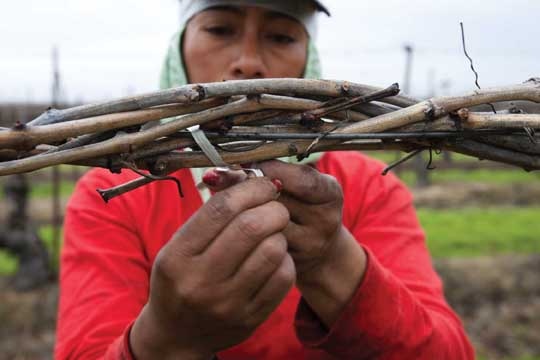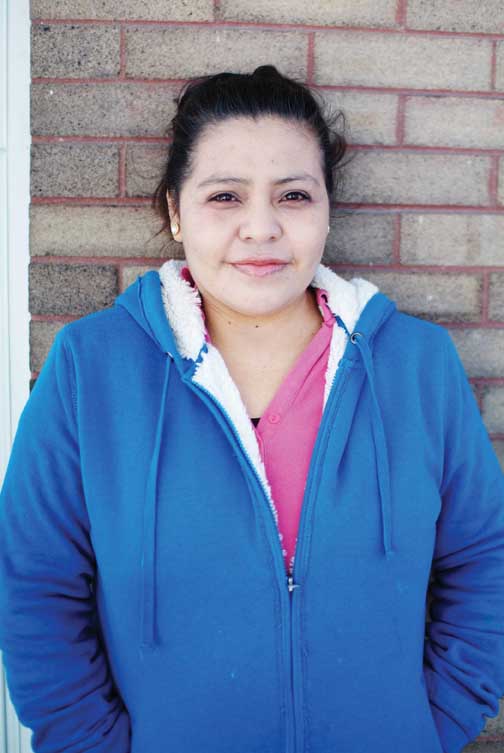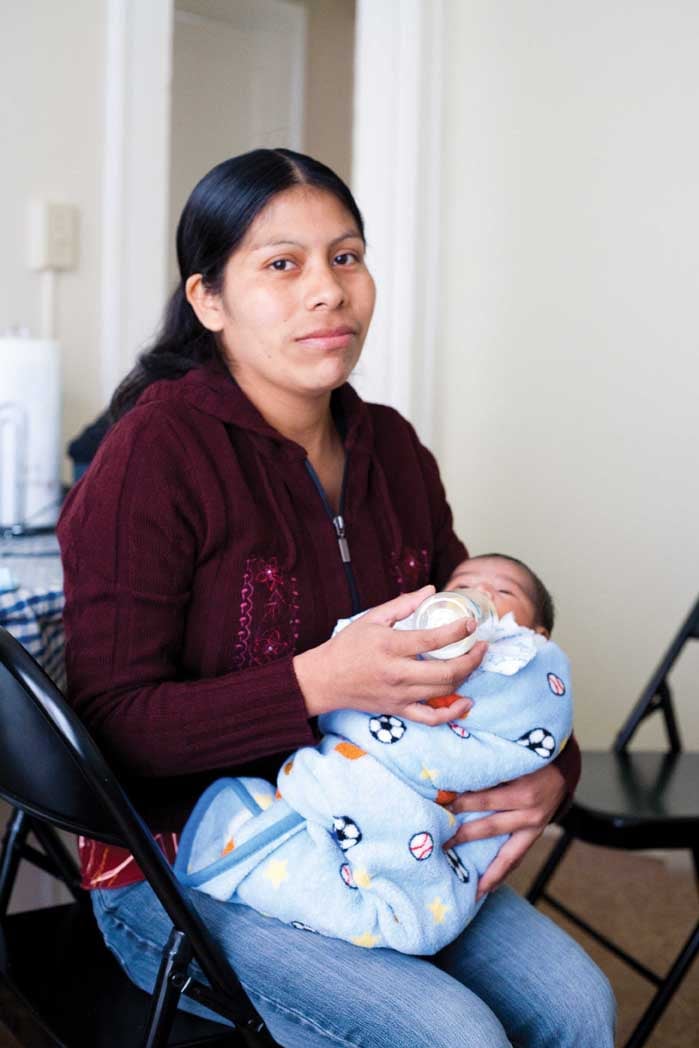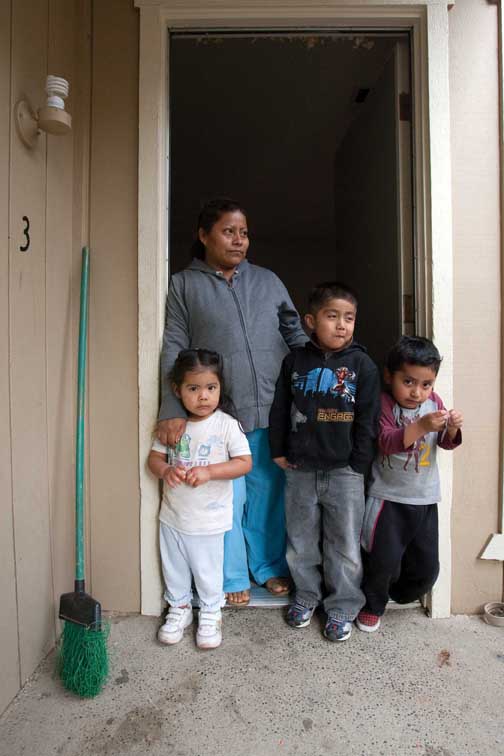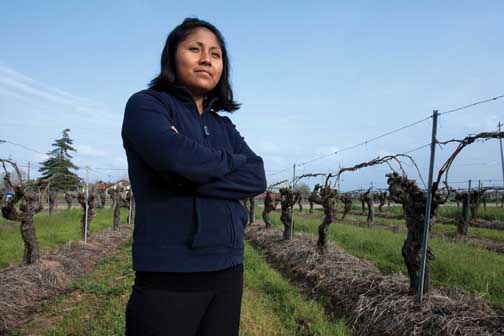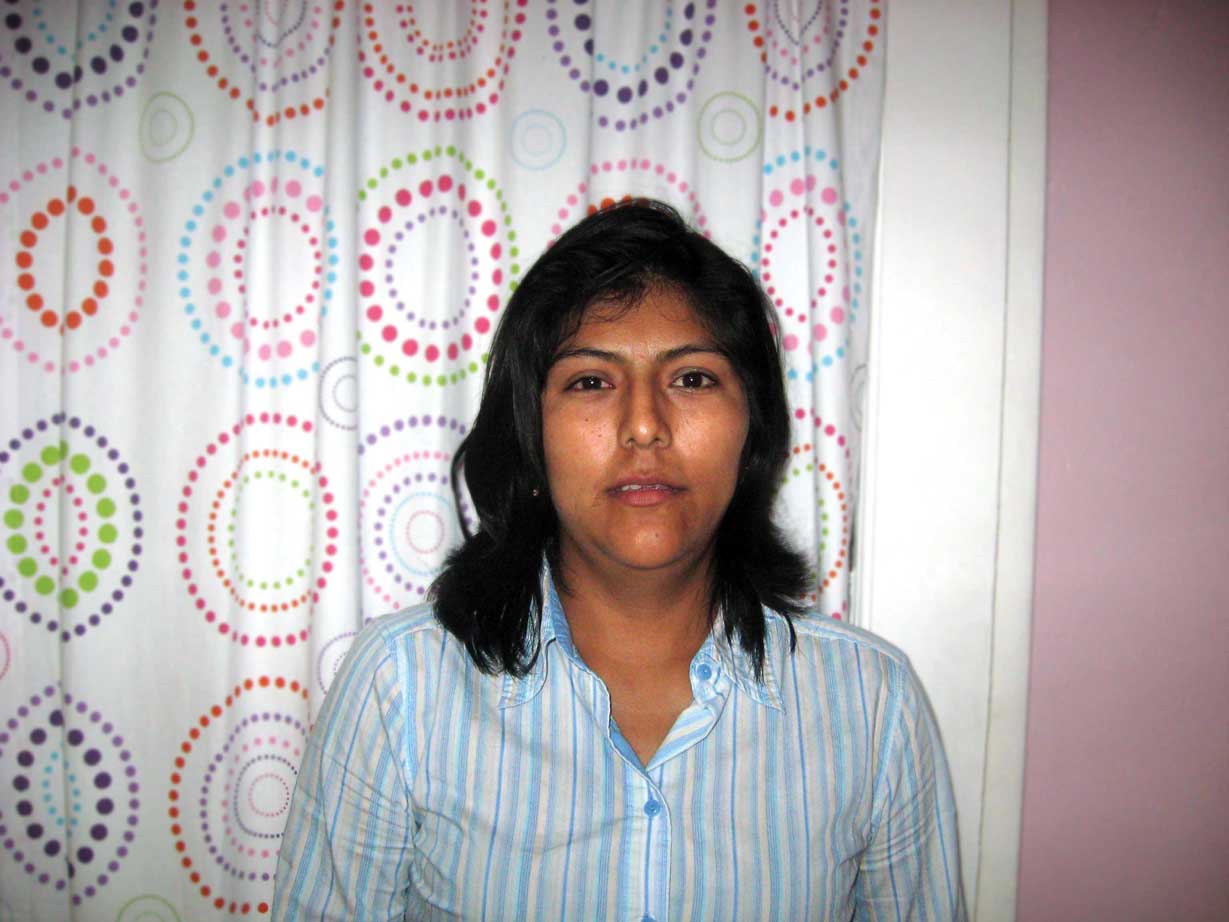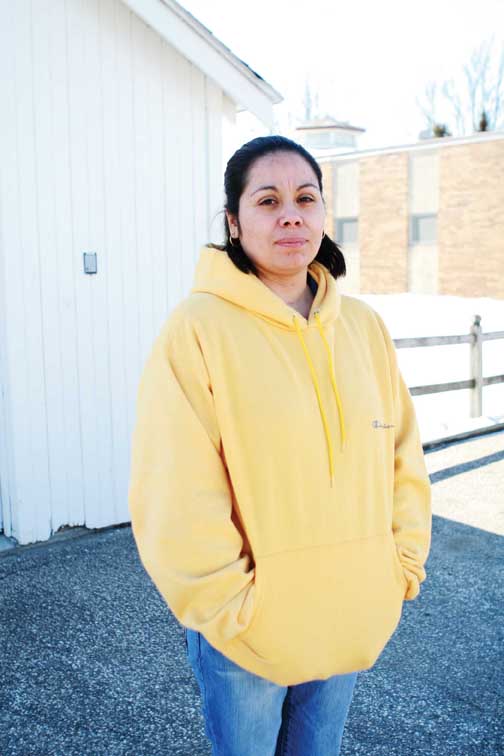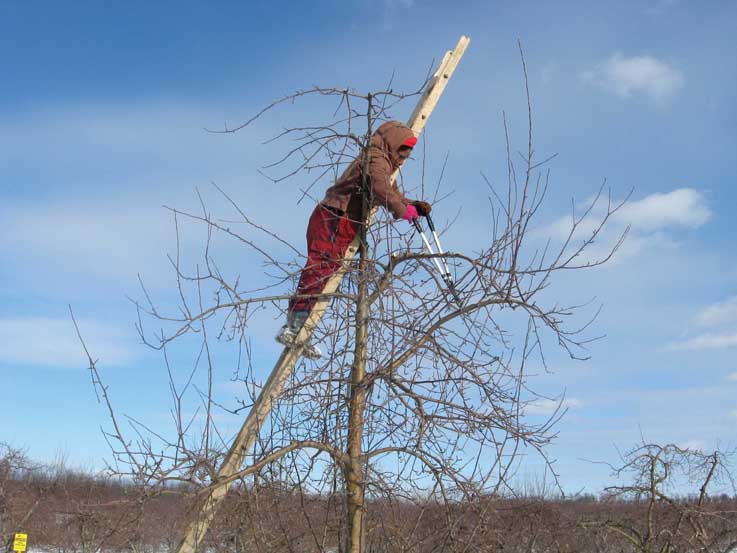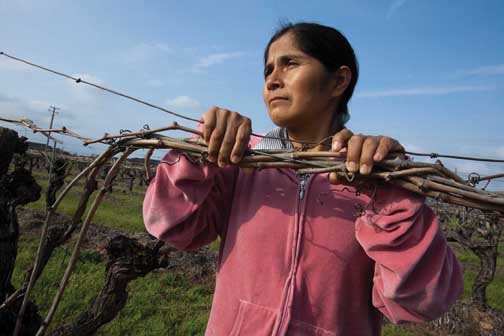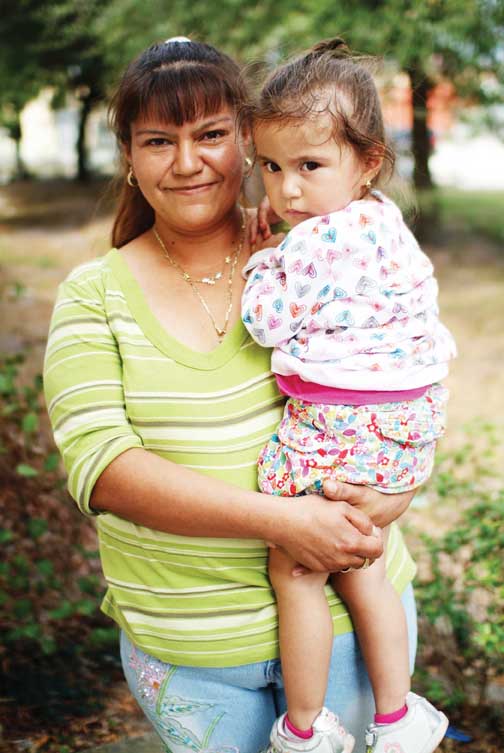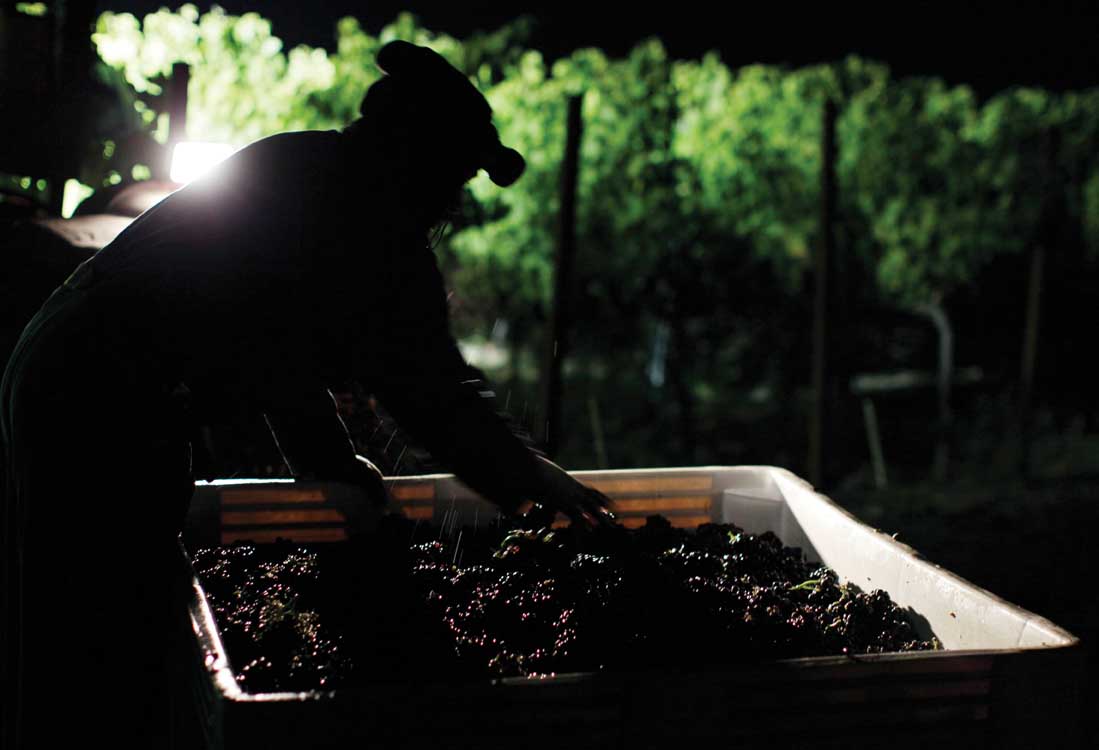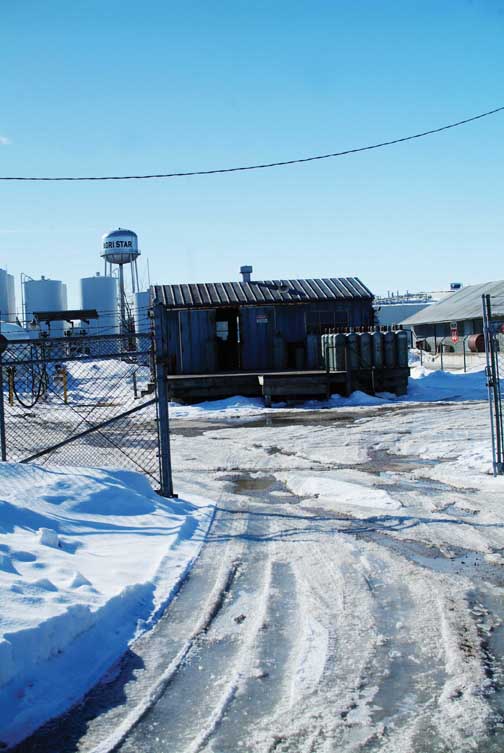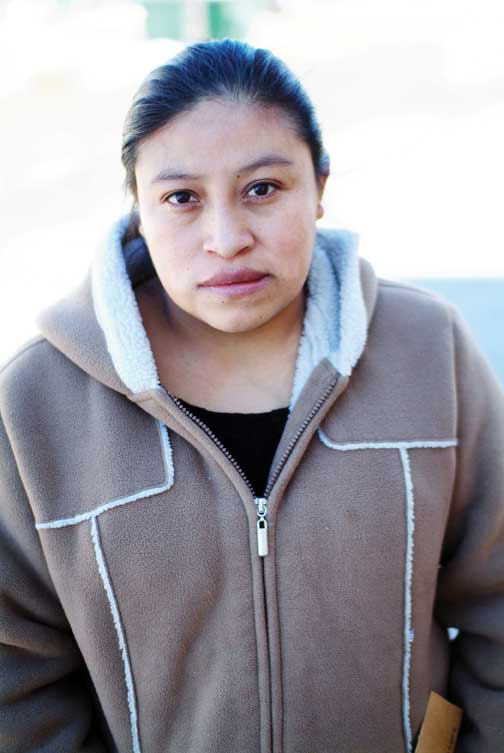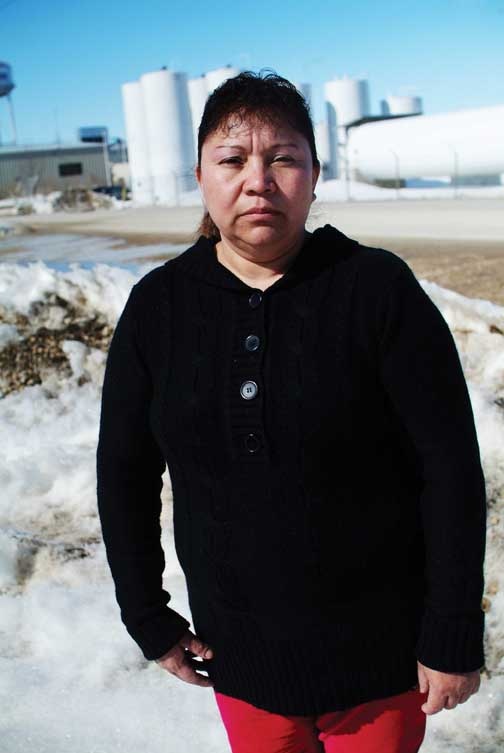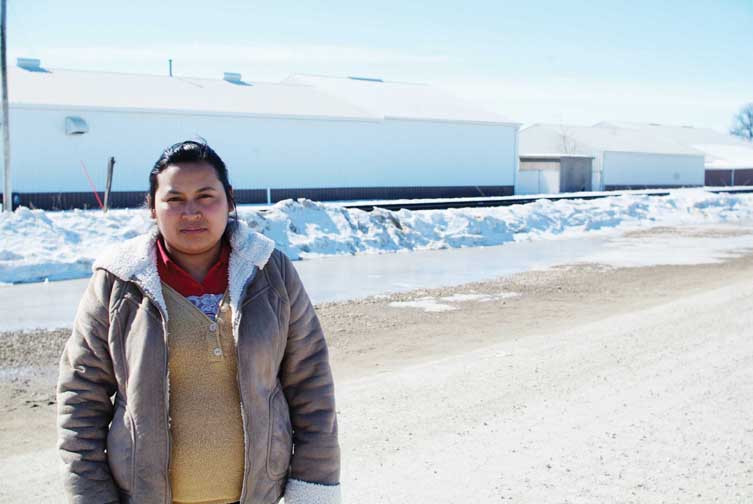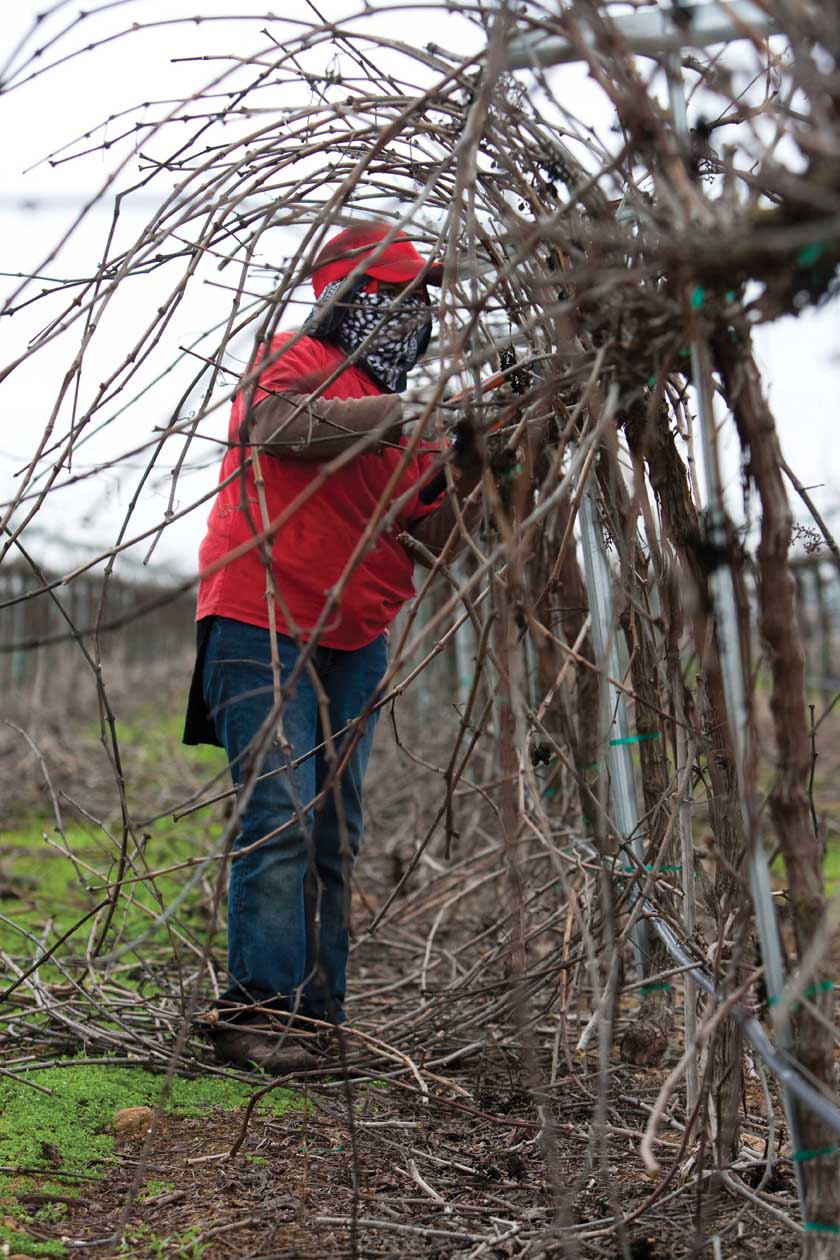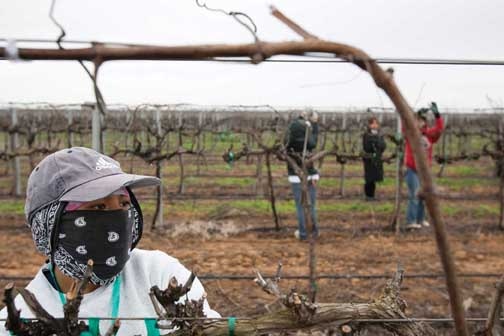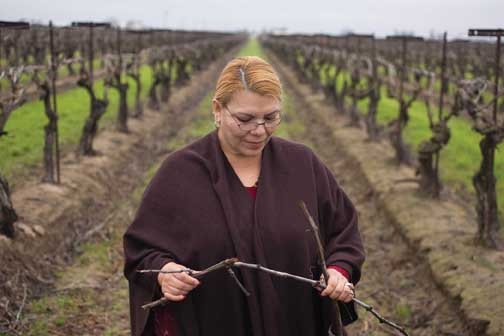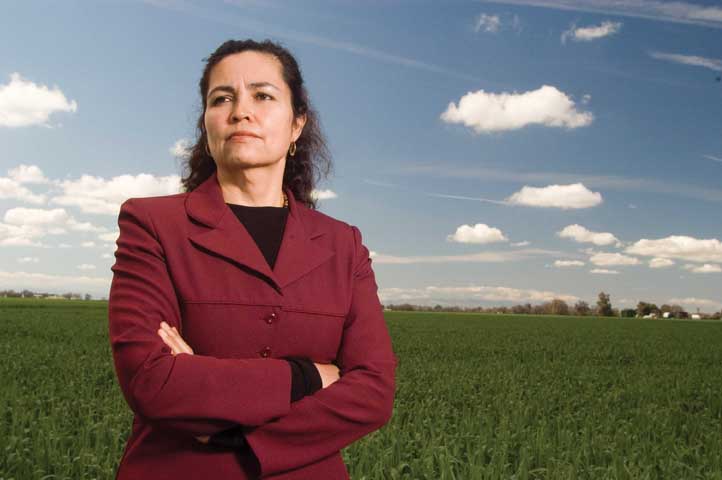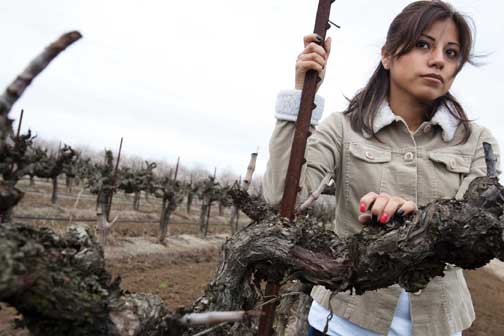Injustice On Our Plates
This report is based on extensive interviews conducted with 150 immigrant women from Mexico, Guatemala and other Latin-American countries. They live and work in Florida, California, North Carolina, New York, Iowa, Arkansas and other states. All have worked in the fields or in the factories that produce our food. They are among the 4 million undocumented women living in the U.S.
SPLC researchers interviewed approximately 150 women who are either currently undocumented or have spent time in the U.S. as undocumented immigrants. The women all have worked in the U.S. food industry in Arkansas, California, Florida, Iowa, New York or North Carolina. A few have now obtained legal status. The interviews took place from January through March of 2010. Researchers also interviewed a number of advocates who work with immigrant women and farmworkers.
The interviews were conducted almost exclusively in Spanish, and recordings were transcribed and translated into English. The women were first asked questions from a standard survey and then, based on their answers, asked by a researcher to elaborate on their experiences.
In most cases, the women quoted in this report are identified by their first name only, to protect their identities. In other cases, in which the subject did not want to be identified in any way, a fictional first name is used. Those names appear with an asterisk.
Authored by: Mary Bauer and Mónica Ramírez
View our Teacher's Guide (PDF) published by Teaching Tolerance.
Facts About Immigrant Women Working in the U.S. Food Industry
Undocumented women are among the most vulnerable workers in our society today. They fill the lowest paying jobs in our economy and provided the backbreaking labor that helps bring food to our tables. Yet they are routinely cheated out of wages and subjected to an array of other abuses in the workplace. They are generally powerless to enforce their rights or protect themselves. The following are facts from the SPLC report Injustice on Our Plates.
Undocumented Immigrants
-
There are an estimated 4.1 million undocumented women in the U.S. today. In addition, 4 million U.S.-born children — citizens by birthright — live in a household with at least one undocumented parent.
-
Undocumented women typically earn minimum wage or less, get no sick or vacation days, and receive no health insurance.
-
Legalizing undocumented workers would raise the U.S. gross domestic product by $1.5 trillion over a decade. On the other hand, if the government were to deport all 10.8 million undocumented immigrants living on U.S. soil, our economy would decline by $2.6 trillion over a decade, not including the massive cost of such an endeavor.
-
Each year, undocumented immigrants contribute as much as $1.5 billion to the Medicare system and $7 billion to the Social Security system, even though they will never be able to collect benefits upon retirement.
Farmworkers
-
There are an estimated 3 million migrant and seasonal farmworkers employed in the United States. The federal government estimates that 60 percent of farmworkers are undocumented immigrants; farmworker advocates say the percentage is far higher.
-
The National Agricultural Workers Survey (NAWS) published by the Department of Labor reports that about 22% of the farmworker population is female. Thus, there are an estimated 630,000 women engaged in farm work in the United States.
-
The average personal income of female crop workers is $11,250, compared to $16,250 for male crop workers.
-
A mere 8 percent of farmworkers report being covered by employer-provided health insurance, a rate that dropped to 5 percent for farmworkers who are employed seasonally and not year-round.
-
According to the U.S. Department of Labor, farmworkers suffer from higher rates of toxic chemical injuries and skin disorders than any other workers in the country. The children of migrant farmworkers, also, have higher rates of pesticide exposure than the general public.
-
Each year, there are an estimated 10,000 to 20,000 cases of physician-diagnosed pesticide poisoning among U.S. farmworkers, according to the U.S. Environmental Protection Agency.
-
Farmworkers are not covered by workers’ compensation laws in many states. They are not entitled to overtime pay under federal law. On smaller farms and in short harvest seasons, they are not entitled to the federal minimum wage. They are excluded from many state health and safety laws.
-
Because of special exemptions for agriculture, children as young as 10 may work in the fields. Also, many states exempt farmworker children from compulsory education laws.
Poultry Workers
-
Almost a quarter of the workers who butcher and process meat, poultry and fish are undocumented.
-
At least half of the 250,000 laborers in 174 of the major U.S. chicken factories are Latino and more than half are women.
-
Working in a chicken factory is one of the most dangerous occupations in America. Line workers endure a frigid and wet work environment, without adequate bathroom breaks, while being exposed to numerous hazards handling chicken on hangers that whiz by a rate of hundreds per minute. The Occupational Safety and Health Administration has not enacted any regulation to limit the speed at which poultry and meat processing lines operate — despite the appallingly high rates of injury directly attributable to the line speed. In the decade ending in 2008, 100 poultry workers died in the U.S., and 300,000 were injured, many suffering the loss of a limb or debilitating repetitive motion injuries.
-
The U.S. Department of Labor surveyed 51 poultry processing plants and found 100% had violated labor laws by not paying employees for all hours worked. Also, one-third took impermissible deductions from workers’ pay.
Sexual Abuse On the Job
-
In a recent study of 150 women of Mexican descent working in the fields in California’s Central Valley, 80% said they had experienced sexual harassment. That compares to roughly half of all women in the U.S. workforce who say they have experienced at least one incident.
-
While investigating the sexual harassment of California farmworker women in the mid-1990s, the U.S. Equal Employment Opportunity Commission found that “hundreds, if not thousands, of women had to have sex with supervisors to get or keep jobs and/or put up with a constant barrage of grabbing and touching and propositions for sex by supervisors.”
-
A 1989 article in Florida indicates that sexual harassment against farmworker women was so pervasive that women referred to the fields as the “green motel.” Similarly, the EEOC reports that women in California refer to the fields as “fil de calzon,” or the fields of panties, because sexual harassment is so widespread.
-
Due to the many obstacles that confront farmworker women — including fear, shame, lack of information about their rights, lack of available resources to help them, poverty, cultural and/or social pressures, language access and, for some, their status as undocumented immigrants — few farmworker women ever come forward to seek justice for the sexual harassment and assault that they have suffered.
-
In interviews for this report, virtually all women reported that sexual violence in the workplace is a serious problem.
They’re the backbone of our food supply.
Their hands sliced the chicken breast we had for lunch. Their sweat brought the fresh tomato to our plates. Their backs bent to pick the lettuce in our salads.
They are America’s undocumented workers. Every single day, virtually all of us rely on their labor. At least six in 10 of our country’s farmworkers are undocumented immigrants — probably many more. On farms across America, they help produce billions of dollars worth of grapes, tomatoes, strawberries, melons, beans and other grocery store staples.
Despite their contribution to our economy, these immigrants live at the margins of U.S. society — subsisting on poverty wages, enduring humiliation and exploitation in the workplace, and living in constant fear that their families will be shattered if they are detected.
Because of their status, they remain in the shadows, their voices silent. They are unable to speak out about the indignities they suffer and the crimes committed against them. As one 59-year-old Mexican woman says: “No one sees the people in the field. We’re ignored.”
This report is based on extensive interviews conducted with 150 immigrant women from Mexico, Guatemala and other Latin-American countries. They live and work in Florida, California, North Carolina, New York, Iowa, Arkansas and other states. All have worked in the fields or in the factories that produce our food. They are among the 4 million undocumented women living in the U.S.
They are the linchpin of the immigrant family. And they are surely the most vulnerable of all workers in America — seen by their employers as easily exploitable and, at the end of the day, disposable.
Their stories are remarkably similar. Virtually all say they came to the United States to escape devastating poverty and to try, like waves of immigrants before them, to lay a foundation for their children’s future. They tell harrowing stories of survival in the desert they crossed to get here. They tell of being cheated out of hard-earned wages by unscrupulous employers. They tell of working in dangerous conditions without adequate safety precautions. And they tell of enduring near-constant sexual harassment in the fields and factories.
The laws that protect these workers are grossly inadequate. More importantly, the workers’ ability to enforce what protections they do have is generally nonexistent.
When the debate over immigration policy once again reaches Congress — the only venue where it can be resolved — it’s important to understand the motivation that drives these women across our borders, their role in our economy and our communities, and the exploitation they face.
They are economic refugees — pushed from their home countries by abject poverty, hunger and desperation. They’re pulled north by the alluring images in their heads of a bountiful country overflowing with opportunity — a meritocracy where one need only work hard to have enough food to eat and to provide decent clothes and shelter. They don’t come here expecting a handout.
Some find their American dream is little more than a mirage. Others, finding a modicum of success, are able to put their children on an upward path and help sustain their relatives back home. Many come to the U.S. for what they believe will be a temporary stay but find their plans to return home complicated by community ties, their desire to give their children the opportunity the U.S. offers and tighter border controls.
These women live at the bottom of a world where titans of finance send capital across borders at the speed of light and transnational corporations move factories — and jobs — around the globe like a chess match to take advantage of the lowest labor costs. It’s a world where trade and foreign policies established in Washington and other faraway places can mean a job or no job to people who have no say in the matter. Though the world’s economy has never before been so interwoven, it’s still a world where people, the workers who run the factories and whose labor helps enrich those at the top, are supposed to stay within the lines.
America is now at war with the immigrant hands that feed us. Communities and states across the country are enacting a patchwork of highly restrictive laws that will only drive undocumented immigrants further underground and make them even more exploitable by the businesses that employ them and the criminals who prey on them. Immigrant women face the additional danger of sexual assault and rape, crimes they often are afraid to report to police because it could lead to deportation.
Not only is this war costing taxpayers many billions, it is eroding wage and workplace protections for U.S. workers as well, especially for low-skilled workers, as businesses find they can exploit immigrant labor with virtual impunity.
U.S. immigration policy has not kept pace with these challenges. Border security has been greatly enhanced. But the reality is that about 11 million people are now living and working in the U.S. without documentation. Millions of them are raising U.S.-born children. Deporting all of these immigrants, according to one recent study, would leave a $2.6 trillion hole in the U.S. economy over the next decade. That does not include the billions of dollars that would be required to enforce such a policy. And it does not take into account the massive human rights violations that would inevitably occur.
Fifty years ago this Thanksgiving, CBS broadcast “Harvest of Shame,” an Edward R. Murrow documentary that chronicled the plight of migrant farmworkers. Murrow closed the program with this commentary: “The migrants have no lobby. Only an enlightened, aroused and perhaps angered public opinion can do anything about the migrants. The people you have seen have the strength to harvest your fruit and vegetables. They do not have the strength to influence legislation.”
Not much has changed.
Congress must address this crisis in a comprehensive way — a way that recognizes the contributions of these immigrants to our country and our fundamental values of fairness and dignity. Our recommendations for doing so appear at the conclusion of this report.
In Mexico, Alma often couldn’t afford milk for her children’s bottles, so she filled them with coffee.
Today, the 39-year-old farmworker lives near Immokalee, Florida, the tomato capital of the United States. Like many of the other women interviewed for this report, she simply wants to spare her children the grinding poverty she experienced in Mexico. “I’d like to live (in the U.S.) for my kids — for them to study and not live the life I lived in Mexico, because it was very hard,” she says.
Like Alma, Maria Concepcion, 27, crossed the border illegally. Four years ago, she swam across the Rio Grande, badly injuring her leg during the journey. After the crossing, her husband left her. Now, she is a single mother living in Florida, with a son in Mexico. Her parents and her child rely on her to send money.
Back home, the pay was too paltry.
“For me, this place was a dream, a hope for me and my family,” she says. Here, with her meager wages picking oranges and working as a cook, she has basic conveniences she could never have had in Mexico: an air conditioner, a stove, a refrigerator, carpet on the floor.
“In Mexico, my house was open,” Maria says. “The cardboard walls would break and bend. My dream was to arrive here for my family, to work. Just that.”
Alma and Maria are among the estimated 6.7 million Mexicans living in the U.S. without legal status. Mexicans make up 62 percent of the country’s 10.8 million undocumented immigrants, according to the Department of Homeland Security’s most recent figures. Four million of these immigrants are women.
Women like Alma and Maria help form the backbone of American agriculture. Their hands harvest the bounty that replenishes our tables. Their hard labor enriches the farmers and business owners who employ them at wages that are simply not enough for American workers.
A glance at basic economic statistics shows why millions of women like them are willing to risk detention, sexual assault, separation from their children and even death just for the opportunity to earn subsistence wages and live at the bottom of U.S. society. In the top four countries that provide the most undocumented immigrants to the United States — Mexico, El Salvador, Guatemala and Honduras— the per capita gross national income (GNI) ranges from about $1,700 to $9,990 a year.
In comparison, the U.S. per capita GNI hovers near $50,000 a year.
By migrating to the United States, Mexican immigrants like Alma and Maria are able to increase their annual incomes by 2.5 times, on average, even after accounting for the difference in the cost of living.
When such disparities exist between neighboring countries, is it any wonder that the poor will ignore the lines in the desert sand?
Looking for a decent wage
Time and again, these Latina immigrants say they don’t want anything given to them. They just want to work hard and earn a decent wage so that their children can get an education and climb the economic ladder, a path that immigrants throughout U.S. history have taken.
Gloria, a 37-year-old Mexican woman who works from July to December packing tomatoes, avocados, mangoes and papayas in south Florida, says she “risked everything” for the opportunity to work in the U.S. “That is the only objective that most immigrants have,” she says. “We don’t come to damage the country but to get ahead and progress.”
The fact is, they’re not eligible for most government benefits. Undocumented immigrants are prohibited from participating in most federal programs that benefit the poor and unemployed, including welfare, food stamps, housing assistance, disability and unemployment benefits, Medicaid and Social Security. Fear of detection keeps many from using the benefits to which they are entitled, such as emergency medical services.
But while they don’t receive federal benefits, most economists agree that their cheap labor results in a net benefit to the U.S. economy. Former Federal Reserve Chairman Alan Greenspan told the U.S. Senate in 2009 that undocumented immigrants have “made a significant contribution to the growth of our economy.”
In addition to their labor, each year undocumented immigrants contribute as much as $1.5 billion to the Medicare system and $7 billion to the Social Security system, even though they will never be able to collect benefits upon retirement.
Deporting these immigrants en masse would shrink the American economy by as much as $2.6 trillion over 10 years, according to one recent study.
The decision to stay or go
The decision to leave their country and culture is not something taken lightly, the women say. Often, family members — children, husbands, fathers, mothers — are left behind. The dangers and cost involved in the journey do not allow for whimsy, and the pain of leaving loved ones is wrenching, often unbearable.
Gullermina, a 30-year-old farmworker in Florida, still cries when she remembers the painful decision she made with her brother to leave their mother behind in Mexico. “My mom became a widow when we were little. She always worked, and there wasn’t enough money. So we had to leave Mexico. Yes, it was difficult,” Gullermina says, her voice trailing off before she bursts into tears. “I don’t think I can go on,” she says, excusing herself from the interview.
One woman from El Salvador left behind three children and a 21-year-old son. Her wages there, $6 a day, were simply not enough to pay for food. She hasn’t seen her children in two years. “Now, more than ever, I feel like my hands are tied,” she says. “I asked myself what I’m doing here. I can’t see them. I can just call them. They have to eat every day, and they ask me if I can send them a little something. And my mom says that if I can’t, that they’ll come here, because they’re suffering a lot because of our separation.”
For many women, the decision to stay in the U.S. or go home is complicated by their children. There are currently 5.5 million children living in households with at least one undocumented parent; 4 million of them were born in the U.S. and are, thus, U.S. citizens.
Edilia, 26, has been in the U.S. almost a decade. She always dreamed of saving enough moneyto build a home in Mexico “and not be here suffering any longer in the fields.” But she doesn’t earn much picking tomatoes in Florida — clearing about $30 a day after paying $10 for a babysitter.
Now, her mother is sick, and she would like to go see her in Mexico but cannot. “I haven’t gone back, because my daughter was born here,” she says. “She has papers and I don’t. How would I come back with her?”
Likewise, Lucila*, 34, had planned to work in the U.S. for only a year and then return to Mexico. She’s now been here for 15 years. “I worked in everything from factories to restaurants,” she says. “I had kids and I couldn’t go back. It’s not easy to go back with three kids.”
Contrary to the “anchor baby” myth, women like Edilia and Lucila are not eligible for citizenship simply because they gave birth here to children, who are automatically U.S. citizens. The fact is that children born in the U.S. to undocumented parents cannot petition for the permanent residency of their parents until age 21. Even if a 21-year-old child does file such a petition to legalize the parent, the parent will likely be subject to a 10-year bar — a requirement that she leave the country for 10 years before she receives legal status. Under this scenario, the parent would finally receive legal status when her child was in her 30s.
Crossing: The fallen have no names
Araceli knew if she stopped walking she would die.
The 26-year-old from Chiapas, the southernmost state in Mexico, had been trudging through thesands of the Sonoran Desert for five days after leaving the border town of Altar, just a one-hour drive south of the Arizona-Mexico border.
Altar was once a small farming community. Now, by some accounts, its entire economy is based on the smuggling of people across the border. For many undocumented immigrants, the town is the final way station before embarking on one of the most dangerous migratory treks on the planet. Popular routes are controlled by unscrupulous human smugglers and terrorized by predatory gangs. The desert, which covers much of the northern Mexico state of Sonora and stretches well into Arizona and California, ranks in some spots as one of the hottest places on the planet during the summer. “The desert deceives you,” Araceli says. “You don’t know where you’re going. You’re easily disoriented.”
This is where the nightmare often begins for women and girls. They are, by far, the most vulnerable during the crossing — and their experience can have an enormous impact on their lives in the U.S. Some academics and humanitarian organizations estimate that as many as six out of 10 women and girls experience some sort of sexual violence during the journey through Mexico into the United States. Definitive numbers are not available because the plight of women attempting to cross is severely underreported and understudied.
The accurate collection of data depicting migrants’ deaths is also challenging because of the number of agencies involved and the differing reporting standards. The U.S. Border Patrol does not include data from the Mexican side of the border, which almost certainly ensures that deaths are underreported.
As illegal immigration began to increase dramatically in the 1990s, the U.S. began a massive buildup of forces along the border. In 1992, there were 3,555 Border Patrol agents assigned to the U.S.-Mexico border. That number increased to 8,580 by 2000. By the end of 2009, it had reached more than 17,000. Meanwhile, the Border Patrol’s budget has more than tripled in the last decade, rising from $1.06 billion in 2000 to $3.58 billion in 2010.
But this manpower hasn’t stopped the migration of people like Araceli. The population of undocumented immigrants in the U.S. has roughly tripled over the past two decades. University of California, San Diego, researchers have found that the vast majority of migrants — as many as 92 to 98 percent — keep trying to cross the border until they make it.
Many of the women interviewed for this report said they were not successful on the first attempt, but kept trying.
“They grabbed me five times, and on the sixth time I finally got across,” says Carina, a 24-year-old woman from Mexico. “It was a hard trip. The last time when we crossed, we walked six days and nights. My mind was set that I was going to cross and come here to work.”
The Obama administration has continued the buildup of border forces, announcing in May 2010 that up to 1,200 National Guard troops were to be deployed to the border. The White House followed that move with a request to Congress for 1,000 more Border Patrol agents.
This enhanced border enforcement may be resulting in more, not fewer, undocumented immigrants staying in the U.S. That’s because, with tighter border control, especially after the terrorist attacks in 2001, the “circular migration” of some migrants was interrupted. They could no longer work in the U.S. and then easily return home. According to one estimate, there were 3.9 million undocumented women in the United States in March 2005; by March 2008 that number had increased to 4.1 million.
In recent years, the crossing has become more expensive and more dangerous. The U.S. government’s “prevention through deterrence” strategy, according to a November 2008 report by the Congressional Research Service, has “pushed unauthorized migration away from population centers and funneled it into more remote and hazardous border regions. This policy has had the unintended consequence of increasing the number of fatalities along the border, as unauthorized migrants attempt to cross over the inhospitable Arizona desert without adequate supplies of water.”
The number of deaths of female migrants along this border has been trending upward since 2000, according to data provided by the Border Patrol. In the five-year period from FY2000 to FY2004, border officers recovered the remains of an average of 61 migrant women a year along the 1,952-mile Southwestern border. In the latest five-year period — from FY2005 to FY2009 — that number jumped to 77.
There are surely many more who are uncounted. Often these migrants go unidentified, their fate forever a mystery to their families.
The Anonymous Dead
Araceli did not want to become another of the desert’s anonymous dead.
“What went through my mind is that this is where [the dead] stay, and the family doesn’t have any recourse,” she says. “There’s no way to claim those bodies. My children are waiting for me, and I don’t want to be like those people.”
Another of her fears had nothing to do with the elements. She was the lone woman in a group of 31 men. The trip was supposed to be completed in three days, but after five days the group from Mexico and Guatemala was still dodging authorities in the desert with very little food or water.
Araceli was falling behind. The smugglers — los coyotes — assured her they would not abandon her. But the mummifying bodies along the route, two young women and a man, told a different story. “I couldn’t stand to see those corpses.”
She questioned the smuggler. Though she never got a straight answer, Araceli suspected the bodies were once his clients and were left for dead when they could no longer keep up. She begged her companions to, if she could no longer walk, drag her to a spot where authorities could find her. The smuggler’s policy on saving stragglers frightened her. “He says, ‘I don’t know, but for one person we can’t risk the whole group, because it’s a lot of money.’” [[nid:3207]]
Typically, undocumented immigrants will pay smugglers anywhere from $1,500 to more than $10,000 to guide them and their families across the border. Often, amounts are far beyond their ability to pay, and they must borrow money or enter into repayment contracts that leave them in debt to the smugglers. Falling deeply in debt leaves immigrants even more vulnerable to exploitation by unscrupulous employers. Araceli borrowed $2,500 to pay for her trip.
Finally, Araceli could no longer move. “I couldn’t walk forward or back.” She sat down under a tree. Overcome by the choking heat, she fainted. When she woke up, Araceli was alone. “They didn’t come back for me. I had to stay there for two days, conserving the little bit of water I had.”
She gave up hope. She thought of her four sons back in Chiapas. “I have a dream of being able to provide for my children,” she says.
Given the anonymity of the fallen migrant in the desert, there was a good chance Araceli’s death would not be recorded or noticed by authorities, let alone reported to her family. She waited for the end.
Luckily for her, a passing group of migrants stumbled across her. At great risk to themselves, they helped her out of the desert.
Today, Araceli is happy to be alive. But the experience has left her scarred. “It was a horrible nightmare that I would never want to repeat.” She eventually arrived in Georgia and took a job in a restaurant where her sister worked. Cutbacks left her without employment, however, and she migrated to Florida, where she found work at a nursery tending plants.
She lost the position, however, when a co-worker’s husband made an unwanted sexual advance. Though she says the man was clearly at fault, Araceli’s boss found it simpler to get rid of the undocumented worker. After losing her job in November 2009, she found temporary, part-time work picking fruit but was driven from that job, again, by sexually explicit overtures, this time from her supervisor. She lasted less than a few weeks at each job and has not worked since. “I’m leaving it in the hands of God to see what happens,” she says.
She is deeply concerned that she will not be able to repay the money she owes the coyotes who brought her over the border. “I owe $2,500, and I don’t know where to find the money to liquidate that debt. And so many problems on top of it.”
Araceli says she arrived in the U.S. with the sole desire of finding work and providing for her family but now feels lost. “I’d like to be in a job that’s well-paid, good treatment, to better myself and others,” she says. “But I’m seeing that everything is very bad.
Dangerous Road
Stories of violent abuse during their migration were common among the women interviewed. Many talked about the prevalence of rape — something so common that some women begin taking birth control pills before migrating to ensure they do not become pregnant. Some described trying to protect themselves from abuse by traveling with a male companion.
Thousands of migrants a year are kidnapped, assaulted, robbed or raped by criminal gangs. According to a recent report by Mexico’s National Human Rights Commission, as many as 9,758 migrants were kidnapped over a six-month period ending in 2009. They are often held until family members pay ransom. In these cases, such payments leave immigrants even further in debt and vulnerable to exploitation in the workplace.
Failure to pay kidnappers can result in death. In August 2010, Mexican authorities discovered the bodies of 72 migrants — 58 men and 14 women — at a ranch near the Texas border. A survivor told authorities that the migrants, believed to be from Central America, had been massacred when they refused to pay extortion fees to the gunmen who had kidnapped them.
Miranda, a Guatemalan who works in a meat-processing plant in North Carolina, crossed into the U.S. as one of two women among 20 men. She asked a man named José to pose as her husband. The decision may have saved her from a horrific attack. “It’s difficult,” she says as she fights back tears, “because they raped my friend.”
Miranda says her friend was frightened into silence during the attack because she didn’t want to be left behind.
Elvira’s story
Elvira, a 32-year-old mother, grew up uneducated in a rural area of the central Mexico state of Zacatecas. She had eight siblings. Her father picked crops. “We were so poor that my eldest sister picked up cardboard boxes to make us sandals,” she says. “It made me so sad that it rained so hard that the rain ruined my sandals, and the water took them away.”
To help her family make ends meet, Elvira went to the state’s capital city to find work cleaning houses. She was, by her own admission, a country “bumpkin” in the big city. “I didn’t know what a phone or a TV was.” She quickly found work with the family of an optometrist, working seven days a week. “It was a two-story house, and I had to clean the optometry office, make food, wash dishes, take care of the kids, clean the tables, iron, wash clothes, everything.”
Elvira was painfully self-conscious of her humble origins but was determined to better herself. “They called me a ranch Indian, and (an) Indian with a mustache, an ignorant person. They said that everyone who lived on farms [was] ugly with big stomachs and with black skin.”
Though her boss resisted, Elvira was allowed to enroll in school with the condition that her studies not interfere with her duties. To keep her job and attend classes, Elvira began her day at 4 a.m. She eventually got her diploma.
The sense of accomplishment was short-lived, however. Her employers accused her of stealing money. Her boss apologized after it was determined one of the family’s children had taken the money, but the damage to Elvira’s pride was done. She returned home to her village and married. “What else can I do here except get married?” she asks. “There weren’t stores to work in, there wasn’t anything.”
Soon poverty forced her hand again. Her husband decided to go north into the U.S. She would follow later. Though they were living in extreme need, the decision was not easy.
“We didn’t have enough for food or shoes. We couldn’t do it anymore. But I thought, how? What if he dies? What if he doesn’t come back? What if he goes and leaves me? So many things go through your mind. But I thought, if I don’t risk anything, I can’t earn anything.”
Her husband crossed successfully. A year later, she attempted to cross. Her brother went first, while she waited in Nogales, a Mexican city along the border with Arizona. For three days, she heard nothing.
Then, while returning to the rundown motel where she was waiting, Elvira saw a “man who was walking with his clothes all ripped, all beat up, full of blood, full of mud and dirt. … It was my brother!”
He had been kidnapped and tortured by the coyotes he had paid. And he had a frantic warning.
“He ran and hugged me and says, ‘Don’t go. Don’t cross. No, let’s go back to the farm, but don’t go. Don’t cross.’”
Elvira was determined. She wanted to keep studying and become a teacher. She believed in the promise that the United States has made to immigrants for more than 200 years: If you work hard, you will succeed here.
After two unsuccessful attempts, Elvira left Juarez in the early morning hours as the lone woman in a group of migrants planning to cross the Rio Grande. Before entering the water, they stripped off their clothes. After reaching the opposite banks, they ran in different directions. As she prepared to sprint after the group, the coyote directed her down another path, telling her that she would be less visible if she didn’t follow the larger group. The skinny, tattooed coyote led her down an isolated trail. She asked him: “But why are you taking me this way?” His response was: “Don’t you want to go to your husband?”
As they continued running, Elvira grew uneasy. They finally stopped. Elvira said a quick prayer to herself. The smuggler continued: “Look little lady, if you want to arrive with your old man, you have to cooperate.”
Elvira says that a word popped into her head that she didn’t completely understand. As the smuggler inched closer, his intentions clear, she told him: “I have AIDS.”
The ruse worked. The man ran away.
“I thought, what could this be that I said? I’ve never told my husband this. Never. Maybe because, I don’t know … I don’t even like to remember it.”
Abandoned by her guide, her third attempt to enter the U.S. failed, and she was detained by the Border Patrol. She made it across on her fourth try with the help of two teenage boys.
Tales like Elvira’s escape from sexual abuse as she crossed the border are in the minority. Once in the hands of smugglers, migrants are typically at their mercy.
Antonia, who crossed into the U.S. in 2006, says that her group of 40 immigrants was crammed into a house when they first arrived over the border. “I felt panic because we heard that they were taking away the women,” she says. In reality, the smugglers were taking only the women from El Salvador.
“We didn’t ask where they had taken them,” says Antonia, who is Mexican. “One of the husbands said that he wanted to go with them, and (he asked) where were they taking them.”
The smuggler simply responded that they were taking the women to another hotel and that there was nothing the angry husband could do about it. “The girl was crying,” Antonia says of the man’s wife. “But what could they do?”
*Not her real name
Soon after crossing into the U.S. in 1998, Maria found herself planting tomatoes in Florida, the country’s leading producer of fresh tomatoes. The 30-year-old Guatemalan with four children once did the difficult work of cleaning hotels in Mexico, but she never worked as hard as she did in the tomato fields.
“I had some friends who said that in the North you earn good money,” she says. “But I’m seeing that’s not the case.”
On her first 12-hour work day, “I cried because I didn’t think I’d make it. Your head hurts because of the [pesticide] spray, your back hurts.”
When working by the hour, Maria says she typically earns $5.75. When working by contract — during harvest, for example — she earns 45 cents for every 32-pound bucket she fills with tomatoes. Racing to make as much money as possible, like many of the more than
33,000 farmworkers toiling in Florida’s tomato fields, Maria runs back and forth, filling her bucket and dumping the load onto a nearby truck.
“You have to run to do 150 [buckets] to make your money for the day.”
That is, when the bosses actually pay.
When not battling the heat, the physical demands and the persistent sexual harassment in the fields, Maria has had to worry if, at the end of a work week, she has given away her labor for nothing.
Of one boss, she says, “He doesn’t let you go to the bathroom, and if you do, he yells at you.”
After putting in two weeks of work, the boss told the workers there was no money to pay them.
Somewhere in America, someone probably paid the full price for the tomatoes Maria picked. But she received nothing. And there was nothing she could do.
A vast army of low-wage workers
Because food production is so labor-intensive, the U.S. food industry requires a vast army of low-wage workers. These jobs — planting, harvesting, processing, packaging and serving our food — have been handed down from earlier generations of immigrants to an increasingly Latino workforce.
Maria is among 4 million undocumented immigrant women living and working in the U.S.
Because of their status, they fill the lowest-paying jobs in the country. They typically earn minimum wage or less, get no sick or vacation days, and receive no health insurance.
Yet, these immigrants play a vital role in our economy, greasing the gears of the great U.S. food machine, which brings a cornucopia of fruits, vegetables, meats, grains, nuts and processed food to our markets and restaurants like clockwork. Like it or not, we eat the fruits of their labor every day.
Farmers depend on them: The government estimates that 60 percent of our country’s agricultural workers are undocumented immigrants. The reality is likely much higher. Food-processing companies depend on them: Almost a quarter of the workers who butcher and process meat, poultry and fish are undocumented.
Restaurant owners depend on them: About one out of five cooks are undocumented, and more than a quarter of the dishwashers are undocumented.
Their economic value is difficult to quantify, but one recent study calculated that legalizing undocumented workers would raise the U.S. gross domestic product by $1.5 trillion over a decade. On the other hand, if the government were to deport all 10.8 million undocumented immigrants living on U.S. soil, our economy would decline by $2.6 trillion over a decade, not including the massive cost of such an endeavor. On top of that, it is assured that farmers and food companies would be scrambling to find the workers necessary to maintain the massive enterprise that brings food to our tables.
Despite their contributions, undocumented immigrants exist in a shadow economy — subject to the whims of unscrupulous employers, unable to assert their rights and, for all practical purposes, beyond the protection of labor laws that protect the rest of us from abuse, discrimination and wage cheating in the workplace.
Disposable workers
The women interviewed for this report all have worked in the U.S. food industry, in places as disparate as New York, North Carolina, Iowa, Arkansas, Florida and California. They have picked tomatoes, lettuce, green beans, apples, almonds, watermelons, strawberries, grapes, oranges, asparagus, plums, blueberries and peaches. They have cut up chickens and packed turkey wings. A few worked as waitresses. Others boxed desserts. Most accepted backbreaking, physical labor with unflinching determination.
Most of the women have little or no formal education. Some are married, many are mothers and most support family members back in their home countries. They are as young as their teens and as old as their 60s.
Regardless of what sector of the food industry these women worked in, they all reported feeling like they were seen by their employers as disposable workers with no lasting value, to be squeezed of every last drop of sweat and labor before being cast aside.
The vast majority of the women, who were interviewed by the Southern Poverty Law
Center over a period of two months in early 2010, said they worked for poverty wages and have been cheated, at one time or another, out of wages they earned. Many reported injuries from the repetitive and strenuous movement required to keep up with the voracious production demands.
Many of those employed in farm work said they have been sickened by pesticides and toxic chemicals. Those working in meat and poultry processing said they labored long hours in bone-chilling temperatures with inadequate safety equipment. Many of the women reported being denied access to bathrooms or barred from taking time off to tend to emergencies like sick children — even when they worked for huge corporate employers required by law to provide those benefits. Some faced illegal discrimination because of pregnancy.
Sophia*, a 37-year-old farmworker in California, came to the United States in 1990 like generations of immigrants before her, full of hope. Those dreams have been dashed. “It is different when you live here; (in Mexico) I saw it in a different way,” she says. “But now that I am here, I see it the way it is. It is very difficult to live here.”
All of these women share an understanding that, because of their vulnerable status, complaining is futile and their livelihoods depend on their tacit acceptance of the status quo.
“It’s because of fear [that] we have to tolerate more,” says Yazmin, a 26-year-old farmworker in Florida. “Sometimes they take advantage because we don’t have papers. They mistreat us, and what can we do? Where would we go?”
A ‘Vicious Cycle’
These women are part of the wave of undocumented immigrants who began arriving during the economic boom of the 1990s and created a large pool of easily exploitable workers. The women are even more vulnerable in the workplace than their male counterparts. They are often the primary caregivers for children, making them less likely to assert their rights for fear of being fired or, worse, being deported and separated from their families. And because of their fear of being reported to immigration authorities, they are reluctant to report wage violations, sexual violence or gender discrimination, or to take legal action to stop it. In some localities, particularly where police have entered into so-called 287(g) agreements with the federal government to enforce immigration law, they are fearful of reporting violent crimes committed against them, because even crime victims can be deported.
Research has shown that intensified enforcement of immigration law by the U.S. government has pushed these immigrants further underground — having the effect of lowering their pay as they become even more susceptible to workplace exploitation. Companies that hire them benefit from lower labor costs, increasing the likelihood that their competitors will follow suit, creating a “vicious cycle” of depressed wages for both immigrants and low-skill, native-born workers alike. And when employers can exploit undocumented immigrants, they have little incentive to make their workplaces safe and fair for all workers.
“They know you’re illegal, and they pay you less than the others,” says Sasha*, who worked at a chicken-processing plant in North Carolina.
While undocumented workers often earn less than U.S. citizens in the same jobs, the women typically earn even less than their male counterparts. That may be why, five years after Congress granted legal status to 1.7 million immigrants in 1986, wages for the previously undocumented women had risen by an average of 20.5 percent, compared to 13.2 percent for the men.
Undocumented workers are largely protected by U.S. labor laws — on paper, at least. Courts have found that all workers, including undocumented immigrants, are entitled to the protection of the Fair Labor Standards Act, which establishes the federal minimum wage and sets rules for overtime pay. Most courts have also held that they are entitled to the protections of Title VII of the Civil Rights Act of 1964, the major civil rights law prohibiting workplace discrimination.
In reality, however, most undocumented workers have no practical way to enforce their rights. And employers know that.
Wage theft prevalent
Wage theft was the most common complaint among the women interviewed. Virtually all said they had been victimized while working in the U.S.
Sometimes, as in the case of Maria in Florida’s tomato fields, they are not paid at all for their work. Typically, there is the implicit, or sometimes explicit, threat that complaints will be met with either firing or a strategic phone call to the police or immigration authorities.
Many women said their pay stubs routinely show far fewer hours than they actually worked. If they question their paychecks or ask for a raise, they are ignored or fired, to be replaced by other desperate workers waiting in line. Although these practices are brazenly illegal, employers know that most of these women will not come forward to complain about violations of the law. They make a completely rational choice to stay quiet, given a legal system that too often fails to protect workers. In the SPLC’s experience, law enforcement is far more likely to support an employer in getting rid of a “difficult” worker than to inquire more deeply and discover the underlying exploitation that led to the disagreement. Indeed, the SPLC has represented several groups of workers who were arrested and/or forced into removal proceedings after they asked to be paid. In one instance, the workers were arrested for “trespassing,” even though they were lawfully on the job during their work hours. These charges were dropped by the prosecutor within 24 hours, but by then the workers were already in immigration proceedings.
“I’d rather not cause trouble,” says Alicia, a 39-year-old Mexican. “It would be worse to lose everything.”
Minimum Wage Rules Routinely Violated
Farmworkers, among the poorest laborers in the U.S., are especially vulnerable to wage theft. Many growers and labor contractors pay “piece rates” rather than hourly wages. This is often a ruse to avoid paying the minimum wage while putting pressure on laborers to work as fast as possible. Under federal law, a farmworker’s weekly pay must equal at least what she would earn under the federal minimum wage for the hours worked. In practice, this requirement is routinely violated, and paychecks regularly misstate the hours worked.
Margot is a 19-year-old farmworker from Mexico who came to the U.S. at 14. She and her husband work seven months in Florida, then migrate to North Carolina and New Jersey as the crops there ripen. “If we stayed here [in Florida], we wouldn’t make enough money because there’s not enough work,” she says.
Each morning, she leaves her two children — a 3-year-old girl and an infant boy — with daycare before starting her long days in the sweltering Florida tomato fields. She says she makes $2.50 for every tray of grape tomatoes she picks. During a typical 12-hour workday, if she manages to work at full speed under optimal conditions, she can gather as many as a dozen trays, about 300 pounds. That’s $30 a day — far less than she would earn if paid the minimum wage of $7.25 an hour. Her one-day tomato harvest retails for as much as $1,000.
Conditions, of course, are never optimal. Employers “do what they want with you,” Margot says. “They mistreat you. When you’re working, you know how many trays you filled, but then the full amount of trays isn’t on your check.”
Carina, a 24-year-old Mexican woman who began working the Florida fields a decade ago as a 14-year-old girl, says she was told by a crew leader that she would earn $6 for every box of green beans she picked. She worked seven days a week and kept track of the boxes she turned in. “At $6, it comes out to be $380 or $400,” she says. “When you get your check, it’s for $250. And we go and tell the crew leader. He says, ‘I don’t know.’”
She hears the same words told to others in her situation: “There are many people who need work, and if you want to work, fine. And if not, fine.”
Catalina, a 33-year-old Guatemalan who left three children behind in her homeland to work in Florida four years ago, says she doesn’t complain when she gets shortchanged “because I need to work and I don’t have papers.”
Women like Margot, Carina and Catalina make up about 20 percent of agricultural fieldworkers in the United States. They often find themselves subject to discrimination by employers who prefer male workers. It is not uncommon for them to experience pregnancy discrimination and to receive less favorable opportunities or work assignments than their male counterparts. They are often given fewer opportunities for advancement. They are assigned to the lowest-paying jobs. And they are typically the first to be laid off. Employers are keenly aware of the women’s desperation to get and keep their jobs, which makes them easy prey.
Like many others, Catalina doesn’t always understand how her pay is calculated. But she knows not to question her bosses.
“Yesterday, I did two [900-pound] tubs [of oranges] at $10, because the trees are so bad there’s no fruit,” Catalina says. “So I earned $20. But when you get the pay stub, it says eight hours. But they didn’t pay us for eight hours. I’m better off keeping quiet, even if they pay me $20 or $30. What can I do? They give me work. That’s what I want. I don’t want anything more. If someone wants to rob me, let them rob me. Only God knows, and God will help me. That’s all I can say.”
Isabel
Like other migrant farmworkers, Isabel’s workday is decided by the season. The 39-year-old farmworker in upstate New York has picked strawberries, grapes and apples. Regardless of the crop, her days usually begin at 4:30 a.m. She and her husband wake up, make a few tacos for lunch and brew up coffee before making their way to the fields and orchards.
“There are a lot of people who can’t take this work,” she says. “I’ve seen that people who just arrived and try this work, they quit. They don’t like it. It’s hard.”
But Isabel and her husband take pride in their work. “We’ve done it for a long time and we know how to do it.”
During her time in the fields, Isabel has learned that a grape vine can live for many years, but it takes a practiced and skilled hand to prune it correctly.
Strawberries also are tricky, she says. “You have to pick them well, and they don’t want them full of snails. They don’t want them to be too ripe or too green. They have to be the right size.”
Working in these fields takes a physical toll. At times, Isabel must spend whole days hunched over. In addition, we “have a lot of hand movement and use big scissors to cut the little branches and cutters for the big branches.”
At the end of the day, the pain can be numbing, Isabel says. “Sometimes I don’t feel my hands. I feel like an animal bit me. I have a pulsing in my arms, and I feel the pain when I sleep. It’s like biting me. It’s intolerable the pain, from using the scissors so much.”
She also suffers from headaches from the pesticides. “It’s such a strong smell,” she says. “When I start to breathe that in, my head starts to hurt, and I feel nauseated.”
She earns roughly $40 a day, but she does not collect a paycheck. Her husband gets a single check for both of them.
It’s not uncommon for immigrant women working on farms and in the food industry to be paid on their husband’s paycheck, an accounting shell game that avoids Social Security, unemployment compensation and disability expenses. Women become, essentially, invisible. The practice is illegal. It has the immediate impact of depriving women of the minimum wages to which they are entitled and the longer-term impact of denying them any chance of qualifying for Social Security or other benefits. It also subjects these women to control by their husbands, partners or male family members, because they do not have the same financial freedom they would have if they were afforded their own pay check. And, if immigration reform is enacted, it will make proving their eligibility for legalization more difficult.
Maria Erica, a 39-year-old woman from Mexico, also experienced such an arrangement harvesting Florida grapefruit. “My husband and I were paid together since we picked together,” she says. “So the check was in my husband’s name. It was his Social Security number. If you got hurt, whether your Social Security number is fake or not, there’s no proof. It’s like you’re invisible.”
When women do receive their own paycheck, it is not uncommon for them to get paid less than male workers receive for the same jobs.
Least protected workers in America
Farmworkers are the least protected workers in America. They were specifically excluded from nearly all major federal labor laws passed during the New Deal era. These exemptions were enacted as part of a compromise between President Franklin D. Roosevelt and Southern lawmakers who wanted to preserve the social and racial order on which the South’s plantation system depended. Some laws have been amended since then, but many exemptions remain. The dire situation faced by farmworkers stems from their lack of economic and political power. Because they have no measurable political influence, there has been little organized opposition to the efforts of wealthy agribusiness interests to deny farmworkers most of the legal protections other American workers take for granted.
Farmworkers, for example, are not covered by workers’ compensation laws in many states. They are not entitled to overtime pay under federal law. On smaller farms and in short harvest seasons, they are not entitled to the federal minimum wage. They are excluded from many state health and safety laws. Farmworkers also are not covered by the National Labor Relations Act and thus have no protection against unfair labor practices when they seek to collectively act for better wages or working conditions, except in the handful of states that have passed statutes extending NRLA-type protections to agricultural workers.
In addition, child labor laws are riddled with exemptions for farmworkers. Children may legally perform farm work as young as 10 years of age. By contrast, 16 is the minimum age for most non-agricultural jobs. In some states, farmworker children are exempt from compulsory education laws.
Undocumented immigrant women already face enormous obstacles. The fact that the law offers little protection against many of the abuses they experience adds further insult.
Pesticides and other workplace hazards
Because of their vulnerability, undocumented immigrants are in no position to protect themselves against exposure to toxic chemicals in the fields or other workplace hazards.
Many of the women spoke about being sickened by pesticides, but they knew virtually nothing about the nature of the chemicals (they commonly characterized them as “white” or “green”) and understood little about safety precautions or their rights.
According to the U.S. Department of Labor, farmworkers suffer from higher rates of toxic chemical injuries and skin disorders than any other workers in the country. The children of migrant farmworkers, also, have higher rates of pesticide exposure than the general public.
If these women do get sick, there is usually no health insurance to help pay for medical treatment. Fewer than 10 percent of farmworkers report having employer-provided health insurance. Several of the women interviewed for this report worked in the Immokalee area of south Florida, where, in late 2004, three children with severe birth defects were born within seven weeks of each other to women who worked in the tomato fields of the Plant City-based grower Ag-Mart.
One child, Carlitos Candelario, was born without arms and legs. Another was so deformed that it was impossible to determine gender without an autopsy after the child died. Carlitos’ parents filed a lawsuit against Ag-Mart, claiming that pesticides caused the birth defects.
According to The Palm Beach Post, Ag-Mart settled the lawsuit in 2008 for an undisclosed amount after an expert said in a deposition that Carlitos’ mother was “heavily” exposed to a “witch’s brew” of pesticides. The newspaper’s investigation also discovered lax enforcement of pesticide regulations.
Lucia, an Immokalee farmworker, said she tries to avoid thinking about her exposure to chemicals, even after a doctor warned of the adverse effects they were having on her. She can’t, after all, leave her job. “At first with the chemicals, I had a lot of headaches and I went to the doctor about that,” she says. “Sometimes I think the more a person worries, the faster they do themselves in.”
Genoveva Vasquez, a 27-year-old Mexican woman, tells of tying grape vines in California vineyards when it began “raining mist.”
“We were all wet, but kept tying,” she says. “I thought it was a fog. [Then] I saw a truck that was spraying. All that white stuff came over to where we were. After, my head hurt. I felt like it got inside. I felt dry … like when you have a cold or flu or congested.”
Every year, roughly 2 billion pounds of licensed pesticides are used in the United States, according to the Centers for Disease Control and Prevention (CDC). The amount is approximately one-fifth of total global use.43
A wide variety of chemical pesticides — insecticides, herbicides, fungicides and others — are used on U.S. crops. Florida’s tomato industry is particularly reliant on these chemicals, using more than 70 different pesticides that are sprayed and dusted at the rate of 217 pounds per acre.
Thousands Sickened by Pesticides
A 2003 study found that in California the most common illnesses reported by farmworkers to the state health department stemmed from exposure to pesticides in the class of chemicals called organophosphates.
The main route of entry was through the skin. Organophosphates became widely used in agriculture after World War II, when Nazi Germany used these compounds as potent nerve agents in chemical weapons.
Each year, there are an estimated 10,000 to 20,000 cases of physician-diagnosed pesticide poisoning among U.S. farmworkers, according to the U.S. Environmental Protection Agency. Given barriers to health care for undocumented workers, these estimates almost certainly understate the problem. The CDC warns that short-term exposure to high levels of pesticides may cause respiratory, gastrointestinal, allergic or neurologic symptoms. Chronic exposure has been linked to a wide range of serious health problems, including cancer, birth defects and other reproductive problems, and neurological disorders.
Many of the women interviewed by the SPLC told stories of headaches, stomach aches and flu-like symptoms after being exposed to chemicals.
“There are times when they’re still fumigating when people go in to work,” says Emilia Guzman, a 38-year-old Mexican woman who describes her work in California vineyards. “My throat started to hurt, I started sneezing, my head started hurting. Many people were sick. I’ve seen where the cherry pickers go in, and I don’t know how they do it, because cherries are covered in liquid. The smell is strong. It’s white and yellow. Then you start sneezing, then your throat and head hurt.”
Gloria, 37, of Mexico, who has worked for years packing Florida lemons, mangoes and other fruits and vegetables, tells of having to wash a white powder off the fruit that is harvested. “When the fruit arrives, it has the white powder on it from the chemicals, and we have to clean it off. And in one way or another, we’re breathing it in. You feel that your throat and chest is filling up. We don’t have anything to cover our mouth and nose with. We’re in constant contact with those chemicals.”
Nothing is accomplished by complaining, says Teresa Hilario, a 20-year-old Mexican woman. Complaints to supervisors are answered with this matter-of-fact response: “If we want to work, fine, and if not, we can go home.”
Elodia, who picks oranges, is resigned to the presence of chemicals in the fields. Like many others, the 50-year-old farmworker from Mexico says the wind sometimes carries a pesticide mist to orchards where workers are present.
It causes “a little vomit or something, but it goes away,” she says.
‘Disassembling’ poultry
Upton Sinclair’s The Jungle remains an influential and powerful illustration of the enduring intersection of labor, immigration and food production in the U.S. When the novel was first published in 1906, the country was shocked at the treatment of workers and the methods used to prepare food.
If Sinclair were writing today, he would not head to Chicago or New York, the meatpacking centers of a century ago. Instead, he might go to Postville, Iowa.
Marta and her husband arrived in Postville in 2005. Even as far away as their native Guatemala, they learned that the meat-processing plant in the small town — called Agriprocessors Inc. — offered jobs to immigrants while ignoring their legal status.
They submitted applications but, to their surprise, were rejected. Workers at the plant soon informed Marta and her husband that they were missing a necessary element in their applications. “At that time, there was [a supervisor] who would give people work if they bought a car from him,” she recalls. “Then he’d deduct the car payments from your check.”
Marta and her husband bought a car and were soon initiated into a workplace so abusive that it would become a symbol of the very worst that present immigration policies could produce.
In one of the largest immigration raids in history, federal officials swept through Agriprocessors in May 2008 and arrested 389 workers — nearly half of the workforce. As the case made its way through court, what emerged in statements from workers were horrific tales of sexual harassment, degrading and dangerous labor practices, and rampant intimidation of a largely undocumented and frightened labor force.
The raid sent a charge through the national immigration debate and made headlines nationwide. Some commentators claimed that Agriprocessors was an aberration.
A ‘time bomb’
But many experts, including Steven Bloom, a professor of journalism at the University of Iowa, say the horrors uncovered at the company were the result of trends that plague the whole industry. “Anyone who was at all aware of meatpacking trends in America realizes that what happened in Postville was a time bomb ready to go off,” he said.
On May 12, 2008, nearly 1,000 Immigration and Customs Enforcement (ICE) agents raided Agriprocessors, the country’s largest kosher slaughterhouse and meatpacking plant. Many of the more than two dozen former Postville workers interviewed by the SPLC were present for the raid and said the experience was among the darkest days of their lives.
Ana, an 18-year-old from Guatemala, said the workday had barely begun when a worker ran by her station yelling “Immigration! Immigration!” Chaos broke out as panicked workers fled from armed officers. Ana started running and quickly found her husband. “I started crying and told him, ‘What are we going to do with our baby?’”
Soon after the raid, stories of the poor working conditions and outrageous mistreatment of workers began to surface. In papers filed to obtain a search warrant, officials mentioned an incident in which a supervisor covered the eyes of a worker with duct tape and then struck the worker with a meat hook. The undocumented worker did not report the incident because “it would not do any good and could jeopardize his job.”
Bloom said it was no accident that meatpacking plants like Agriprocessors began leaving major urban centers and relocating in small rural towns like Postville, which has a population of little more than 2,000 residents.
“It was economics 101,” Bloom said. “There’s very little union (presence) in middle America, minimum wage is an acceptable wage, and there’s very little government oversight.”
Constant humiliation
Luz* said supervisors would humiliate workers if they could not keep up with overwhelming production quotas. At one of her various jobs at the plant, she sliced the fat from chicken breasts. As she scraped and cut as fast as she could, a supervisor would often stand next to her with a stopwatch.
“We had to do 16 breasts per minute,” she says. Many of her co-workers would suffer disfiguring injuries to their hands and wrists from repetitive and strenuous motion on the production line.
Dull instruments made the work harder and the pain greater. If workers wanted better equipment or safety gear, it would be deducted from their wages. “If I told them that my knife wasn’t sharp, they charge $10,” she says. “So, for them not to deduct from my check, I put up with the dull knife. So when I wanted to cut the breast, I had to apply a lot of pressure with my hand because I had to cut bone. I couldn’t take the pain in my arm.”
Luz recalls one supervisor who would curse and berate workers, once saying that “since we didn’t have papers, we had to put up with everything he said to us. And, yes, I believed that since we were illegal, we had to take everything he yelled at us and told us.”
She would eventually suffer a miscarriage after being told to lift 70-pound containers.
Workers were often denied permission to go to the bathroom. Lunch breaks were timed to the second and allowed little time for eating.
Alma, a 39-year-old woman from Guatemala, said that on one occasion she was repeatedly told by a supervisor that she would risk her job by taking a bathroom break. She did the only thing she could. “I urinated on myself,” she says. The supervisor laughed at her. “I came home and didn’t tell my husband anything.”
In addition to resulting in embarrassment and additional stress, refusing to allow women to use the bathroom can have health consequences, such as an increased number of bladder and urinary tract infections.
Irma, 30, who also came from Guatemala, said that runoff from the slaughterhouse would often back up into the workers’ cafeteria. “When the cow slaughter backed up, all the dirtiness formed a canal in the middle [of the cafeteria],” she says. “The tables were here, and the waste passed under the table, and that’s where we had to eat.”
Underage workers were common at the plant. Cindy, from Guatemala, was 15 when she started working in Agriprocessors. “I got some papers that said I was older than I really was,” she says.
Cindy lasted just eight months, in part because she couldn’t tolerate the smells. “It was from the chicken,” she says. “I think it went bad because they kept it so long.”
Most of the Postville workers said sexual harassment was widespread and constant. Rosa, a 38-year-old woman from Guatemala, says that her shift supervisor would sneak up behind women and grab their breasts and backsides. “I felt very ashamed.”
In June 2010, a federal judge in Iowa sentenced Agriprocessor’s manager to 27 years in prison on financial fraud charges. The manager, however, was found innocent of 67 charges of child labor law violations.
Most of the immigrants who were arrested by authorities served sentences of up to five months for identity theft and were deported.
Lost fingers, dull instruments
The horrible work conditions were not confined to Agriprocessors. Many of the women interviewed by the SPLC have worked in other poultry-processing plants. They spoke of their injuries, their chronic pain, the humiliating conditions and the numerous hazards in plants where chickens on hangers can whiz by at a rate of hundreds per minute. The Occupational Safety and Health Administration, the federal agency charged with protecting workers’ health, has not enacted any regulation to limit the speed at which poultry and meat processing lines operate — despite the appallingly high rates of injury directly attributable to the linespeed.
Sometimes, people lose fingers. Martina, 32, of Guatemala recalls witnessing one such incident at a chicken plant. “There was a boy working with a machine, and he cut off his finger. The finger stayed in the machine.”
After some searching, the finger was found. “Since the office didn’t take him to the hospital quickly, the finger wasn’t any good anymore. They threw it in the trash.”
The work was, at times, extremely cold and wet for long hours at a time. “The first day, I’ll never forget,” Martina says. “We were at the table, and the water from the chicken falls and spills on your apron and on my shoes. At the end of the day, I couldn’t feel my feet because they were very wet and cold. I worked for a whole week like that. I could barely walk after work.”
Fabiola* worked at a chicken processing plant in North Carolina. She has performed several jobs in the industry, but cutting chickens into pieces with dull scissors ranks among the most difficult. “When you work with the scissors, sometimes we were in the department the whole night cutting, and it’s an amazing amount of chicken that comes out. The band is spinning around, and on the other side all the chicken is dropping out.
“So you had to work fast to get the chicken off the band. And it just keeps dropping. There’s no way to wait or delay it. We hurt our fingers, we got blisters, because sometimes the scissors weren’t good. Or they weren’t sharp. We had to wrap our fingers in Band-Aids because with so much force we hurt our hands.”
Fabiola says the production demands were unreasonable. “I felt like I was going to faint,” she says. “I think that was my biggest problem. The line was too fast. If the crew leader said we weren’t going to get the order out in time, he’d speed it up.”
Milagro, a 37-year-old former poultry worker from Guatemala, says she left her job at the North Carolina plant when she started developing a flesh-colored growth — soft to the touch and about the size of a baseball — on her wrist. She gritted her teeth and ignored the pain for as long as she could. “Little by little, it started swelling,” she says. “It would go away, then come back. Now, it just stayed and hasn’t disappeared.”
She adds that she struggled with the cold temperature in the plant, set by the managers to keep the meat fresh.
“You see your breath in the air. You can see it because of the cold, and your nose runs because it’s too cold,” she says. With the relentless speed of the line, workers often don’t have time to even wipe away the mucus. “Sometimes you see some gross things there.”
Olivia came to the U.S. from Mexico to escape an abusive relationship. “I suffered a lot with my husband,” she says. “It was a lot of mistreatment and beatings.”
But what the 46-year-old meatpacking worker experienced in this country was a greater horror that haunts her still.
Early one morning, after a 12-hour shift, she found her car buried beneath a heavy Iowa snowfall. As she waited there with a co-worker, one of her supervisors came walking toward her. The women were both wary of the man. He frequently made unwanted and obscene sexual advances inside the plant where they worked and was growing more aggressive. “I’m getting out of here because that dirty old man is coming,” Olivia’s co-worker said as she slipped away.
The supervisor invited Olivia to climb into his truck, assuring her that he would be a gentleman.
“It was 3 a.m., and there was a lot of snow and he started saying things to me, for me to go with him, to sleep with him,” Olivia recalls. She refused and insisted that he go away.
Olivia was fed up and tired. The work at a meatpacking plant was difficult. Adding a steady torrent of sexually explicit and belittling comments made the job nearly unbearable. She had had enough. “I told him ‘no,’ and I threw down my lunch.” [[nid:3215]]
His viciousness caught her by surprise. The supervisor punched her in the face. Olivia crumpled. Dazed, she fought back, but the supervisor’s powerful arms kept her pinned. He grabbed and tore at her clothing. A pick-up truck approached and shined its headlights. “Hey, what’s going on?” the driver asked in English. The supervisor responded in English. The driver, apparently satisfied, drove away.
The man tightened his grip and struck her in the head. Olivia slumped over and passed out. When she awoke, she saw the tracks left in the snow as she was dragged to a nearby bench. Still in a fog, Olivia was vaguely aware that her pants had been removed. The supervisor raped her.
During the attack, Olivia lost consciousness again. When she awoke, Olivia was alone. She noticed a crumpled $20 dollar bill nearby on the ground. She dressed and stood up. That’s when she first became aware of the excruciating pain. She made her way home.
“I saw that my pants had a lot of blood,” she recalls. “My mom asked what it was, but I didn’t want to tell her. I went to bed and didn’t say anything. I don’t even want to remember it.” She sought medical attention the next day. The doctor, who spoke Spanish, was alarmed by her injuries and encouraged her to report the attack to the police. She refused. “No, I was scared of the police,” she says. “And I was scared of [the attacker].” She gave up on seeking justice in hopes of finding a little peace.
Returning to work was difficult.
She tried to report the attack to upper management, but her complaints were met with indifference. “What is so bad about that,” another supervisor asked Olivia. “He left you in one piece, didn’t he?”
She responded the way many undocumented immigrant women do when faced with similar circumstances: She stayed on the job. “I had a lot of need, and if I didn’t go to work, what would I do? I had to pay a lot of rent, many bills, my sick daughter, my sick parents who depend on me.”
Olivia buried the pain and shame of the attack. It wasn’t until recently that she sought out therapy. Her counselor did not believe the extent of the savagery until Olivia provided a medical report.
Undocumented immigrant women like Olivia are, in most cases, virtually powerless to protect themselves against such attacks. They do not know their rights. They often fear, quite rationally, that reporting abuses will lead to job loss and, in some cases, deportation and separation from their children. Some feel too much shame to report harassment or sexual violence, leaving them extremely vulnerable to exploitation by male co-workers or supervisors. Often, they are faced with threats of firing or offers for jobs in exchange for sex. Their abusers use their lack of legal status against them, knowing they are not likely to report sexual harassment or even violent attacks.
Because of the many obstacles arrayed against them — fear, poverty, shame, lack of access to legal resources, language barriers, immigration status and cultural pressures — few immigrant women ever come forward to speak out against the wrongs committed against them. Too often, they are forced to compromise their dignity — to endure sexual harassment and exploitation — to obtain a better life and a measure of economic security for themselves and their families.
‘Perfect Victims’
Sexual predators view farmworker women and other undocumented women as “perfect victims” because they are isolated, thought to lack credibility, generally do not know their rights, and may be vulnerable because they lack legal status. Often, the perpetrators begin the harassment by grooming the women through suggestive comments or unwanted compliments. They may attempt to scare the women, wear them down and further isolate them until the perpetrator is in a position to commit a sexual assault or rape.
There has been little research on the extent of sexual harassment and abuse of undocumented immigrants. But the anecdotal evidence and the few studies that have been conducted suggest that sexual harassment and violence — including offensive comments, grabbing and touching, humiliation and repeated inappropriate propositions — is rampant.
A majority of the women interviewed by the Southern Poverty Law Center said they endured some sort of sexual harassment that, at times, rose to the level of sexual assault while working in the fields, packinghouses or processing plants.
Many, however, were not even familiar with the concept. As less acculturated immigrant women, they struggled to understand the notion of sexual harassment, let alone grasp the means and methods of reporting an incident. Indeed, many were not aware of their rights and seemed to regard incidents of sexual harassment and sexual violence as yet another unpleasant aspect of their job that they had no choice but to endure.
Maria, a 30-year-old farmworker in Florida, says she is filled with anger when she thinks about all the sexual harassment she has suffered. “I really didn’t know [what sexual harassment was],” she says. “If I would have known about it, I would have [reported it].”
Many of the Latinas, ingrained with the culturally reinforced idea that a woman shares blame if she is sexually victimized, expressed bafflement when they found themselves the target of sexual harassment.
Maria, a 57-year-old field worker from Oaxaca, Mexico, who picks grapes and strawberries in California’s Central Valley, says she could not understand why a certain supervisor kept touching her inappropriately while she was going about her job.
“Well, I felt bad,” Maria says. “I felt bad because I didn’t know why he would do that to me. When you don’t give him a reason, he shouldn’t abuse a person.”
Genoveva, a 27-year-old farmworker in California who has picked grapes, peppers, asparagus and other produce, worked for a man who offered her $500 for sex and often made her uncomfortable with his lecherous stares. The supervisor, who drove a van, also happened to be her only means of reaching work. She hated the unwanted attention but never spoke up. She felt relieved when she found another means of transportation.
“I felt depressed, I felt like leaving that job,” she says.
Alina Diaz is an advocate for farmworker women in upstate New York. She travels to labor camps armed with Spanish-language information on sexual harassment, rape and violence. She says sexual harassment is a fact of life for many Latina farmworkers, who are among the poorest and most easily exploitable workers in America.
“It’s very serious,” Alina says. “The women complain a lot that the crew leaders and supervisors, even the contractors [harass them]. For [the women], it’s hard to talk about this. They’re ashamed or afraid that someone will say they asked for it or said something to provoke it.”
This problem, of course, also affects farmworker women who are U.S. citizens or have legal status. But most farmworker women do not have legal status, and that makes them even more vulnerable than farmworkers who are legal. The federal government estimates that 60 percent of farmworkers are undocumented immigrants; advocates say the percentage is far higher. Most studies show that about 25 percent of farmworkers are women.
While investigating harassment of farmworker women in California in the mid-1990s, the U.S. Equal Employment Opportunity Commission (EEOC) found that “hundreds, if not thousands, of women had to have sex with supervisors to get or keep jobs and/or put up with a constant barrage of grabbing and touching and propositions for sex by supervisors.”
In Salinas, Calif., a worker told the EEOC that farmworkers there referred to one company’s fields as the field de calzon, or “field of panties,” because so many women had been raped by supervisors there. In Florida, women farmworkers dubbed fields “the green motel” for the same reason. In Iowa, women said they had encountered the problem so often that they believed it was a common practice in the United States to exchange sex for job security.
More recently, a study published in January 2010 found that among 150 Mexican women and women of Mexican descent who were working in the fields of California’s Central Valley, 80 percent said they had experienced some form of sexual harassment. That compares to roughly half of all women in the workforce who experience at least one incident. Virtually all of the women in the California study who reported sexual harassment said they also experienced sexist comments and degrading insults.
The 2010 study cited a confluence of factors — including extreme poverty, language barriers and discrimination based on race, class and gender — that make farmworker women extraordinarily vulnerable to sexual abuse. It also cited the nature of farm work as a major factor. Not only are farmworker women dependent almost entirely on men for their continued employment, their assignments and the evaluation of their work, they often are assigned to work in isolated orchards or fields far from co-workers. Further, the nature of the work, the continuous stooping necessary to pull weeds from tomato fields or pick crops such as strawberries, lettuce and broccoli make the women susceptible to “sexual stares, verbal comments and unwanted grabbing.”
“No one sees the people in the field,” says Virginia Mejia, a 59-year-old farmworker from Mexico who worked in the California vineyards. “We’re ignored. You have to let them humiliate you, harass the young girls just entering the field. Imagine, they have no protection. You allow it or they fire you.”
The EEOC filed suit against a company called Rivera Vineyard on behalf of Mejia and 56 other women, claiming sexual harassment, retaliation and sex discrimination. The company denied the allegations but settled for $1.1 million in 2005. Mejia lost her job and was blacklisted by the industry.
While sexual harassment in other parts of the U.S. food industry, including the meatpacking industry, has been studied even less than in agriculture, anecdotal evidence, the growing presence of undocumented Latinas in meatpacking plants and a few high-profile cases suggest that the problem in the factories rivals that of the fields.
Few lawsuits brought by immigrant women
In terms of taking legal action to stop abuses or to hold abusers and their employers accountable, the odds are stacked against these women. Very few lawsuits have been brought by farmworker women or other undocumented immigrant women.
It wasn’t until more than 40 years after the Civil Rights Act of 1964 was enacted that a farmworker woman had her case heard before a federal jury. That was a lawsuit brought by the EEOC on behalf of Olivia Tamayo, a migrant farmworker from Mexico who spent 25 years picking crops for Harris Farms in California’s Central Valley.
In a 2005 trial, Tamayo told the jury she was raped repeatedly by a supervisor who threatened her with a knife and gun and said he would kill her husband if she told him. She tried to tell a deputy sheriff, but a company representative intervened, and no criminal charges were ever filed. The EEOC said she was subjected to repeated verbal sexual harassment and intimidation, sexually offensive and threatening gossip from co-workers, and retaliation from the company, including suspension after she reported the harassment. Eventually, she was forced to resign. The jury awarded her nearly $1 million in lost wages and other compensatory and punitive damages. The decision was upheld by the 9th U.S. Circuit Court of Appeals in 2008. To date, Tamayo’s case is the only one to reach a federal jury.
Ultimate responsibility for sexual harassment rests with employers. Employers do not have free rein to discriminate against employees simply because they are not legally eligible to work in the United States. The belief that undocumented women who are victims of sexual harassment or sexual violence, or gender discrimination, are not entitled to relief, in fact, flies in the face of the great weight of law under Title VII of the 1964 Civil Rights Act. Similarly, some states afford protection against sex discrimination that is parallel to and, in some cases, more extensive than Title VII.
In one precedent-setting decision, for example, the U.S. Supreme Court held in 1984 that an employer violated the National Labor Relations Act by firing undocumented workers because of pro-union activities, even though immigration laws made them ineligible to work in this country.
When considering Title VII discrimination, courts have likewise consistently held that the same rationale applies to protect undocumented workers from discrimination. Thus, there is no question that undocumented immigrant women who have been sexually harassed are protected by Title VII and that their immigration status (and that of any witnesses) is irrelevant to establishing whether they have brought forth legitimate claims of discrimination.
In recent years, however, employers have been emboldened by the Supreme Court’s decision in Hoffman Plastic Compounds, Inc. v. NLRB in 2002. Hoffman essentially found that undocumented workers who complained (under the National Labor Relations Act) and experienced retaliation for supporting a union may not receive pay for lost work when they sue. This perverse ruling provides an enormous incentive for employers to hire undocumented workers — and little incentive for employers not to abuse them.
Of course, having rights in the workplace, on paper, and having the ability to exercise those rights are different matters entirely. Many of the women interviewed for this report said that, as a practical matter, it was best to remain silent. Their overriding concern is their precarious economic and legal status. The women know their low-paying jobs are hanging by a thread, and the prospect of deportation hangs over their heads like the sword of Damocles.
Fear of the police
When sexual harassment crosses the line into sexual violence, it becomes a matter for not only the civil courts but the criminal justice system. But many of the women interviewed said they were in no position to report crimes, primarily because of their fear of being deported, even as crime victims.
Their fears seem well-justified.
There are no legal protections to stop law enforcement officials from turning crime victims — even victims of rape — over to the U.S. Immigration and Customs Enforcement (ICE). The SPLC is aware of several cases in which female crime victims have been deported and several cases in which victims of trafficking were prosecuted by both state and federal law enforcement entities instead of being protected when they stepped up to complain.
Another chilling factor is 287(g), the provision of federal immigration law that was created to help immigration authorities capture criminals who threaten the community or national security. It allows local law enforcement officials to check the immigration status of suspects who are arrested and to turn undocumented immigrants over to federal authorities. As of October 2010, the government had such agreements with 72 law enforcement agencies in 26 states. According to the Department of Homeland Security (DHS), the program is credited with identifying 173,000 “potentially removable aliens,” mostly at local jails, since the beginning of 2006.
But though it was intended for criminals, 287(g) has been used by many localities as a cudgel against otherwise law-abiding, undocumented immigrants. Minor traffic stops, for example, can result in detention, deportation and instant separation from children and other family members.
A report released in March by the DHS inspector general shows how the program has been abused by local law enforcement agencies. Out of 280 cases examined, only 9 percent (26 immigrants) involved immigrants convicted of or arrested for crimes such as murder, rape, robbery or major drug offenses — crimes that make these cases the highest priority for ICE. This is not only a serious failure and waste of resources but a prescription for more crime in our communities. When the SPLC surveyed low-income Latinos in two areas with 287(g) agreements in 2009 — Nashville and Charlotte — it found that most were reluctant to cooperate with police because of these agreements.
In May 2010, U.S. Attorney General Eric Holder met with 10 top police chiefs from around the country about Arizona’s new immigration law, which requires police to determine the immigration status of anyone they stop and suspect is in the country illegally. The chiefs told Holder that local law enforcement efforts are seriously hampered by such laws. “If people don’t come forward to help the police solve and protect against crime, no matter what their status, then we are doomed to failure,” Los Angeles Police Chief Charlie Beck said. “It threatens to destroy a lot of the work that has been done.” The Justice Department has since filed a federal lawsuit to overturn the Arizona law, saying it unconstitutionally usurps federal authority, disrupts immigration enforcement efforts and would lead to police harassment of those who cannot prove their legal status. At least five other suits have been filed as well, mostly by civil rights groups that claim the law promotes racial profiling.
A rapist goes free
Even in areas without 287(g), the fear of police in immigrant communities can be pervasive and devastating. In 2007, for instance, the SPLC was contacted by a Latino family in south Georgia after a 13-year-old girl had been raped by a man known to the family. The local prosecutor said he would be willing to prosecute the suspect but added that he felt obligated to report the girl to immigration authorities if he discovered she was undocumented.
The family decided not to pursue the case. The rapist went unpunished.
Alina, the farmworker advocate in New York, said that in addition to fear of deportation, there are other reasons — including language barriers and police indifference — that explain why women don’t report crimes. “Sometimes, the police call immigration,” she says. “Or the officer who comes doesn’t have training in domestic violence or sexual violence. They view these women as disposable. Because they’re immigrants with no documents, they’re not human.”
Victims of domestic violence, sexual assault, human trafficking and other crimes are eligible for temporary legal status under the U visa program created by Congress in 2000. The program however, has been plagued with problems. It took eight years for the federal government to issue the first U visa. By the end of 2008, it had issued just 65, even though about 13,300 people had applied, an investigation by the Los Angeles Times found.
Under the Obama administration, the program has been revived. But that has led to a different problem: By July 2010, the government had issued all 10,000 U visas available for the 2009-10 fiscal year.
In addition, U visas don’t protect victims of every crime. For example, the statute under which they were created — the Victims of Trafficking and Violence Protection Act of 2000 — may offer little protection for workers who experience wage theft or other types of abuse on the job.
More importantly, very few victims of crimes are aware of this potential remedy. Instead, they often endure horrendous abuse, believing that they have little choice.
The SPLC is aware of at least one case in which recipients of U visas were actually prosecuted for possessing false documents when they came forward to report serious abuse on the job. These actions severely undermine systems created to protect vulnerable workers.
Unfortunately, all of these factors combine to leave undocumented immigrant women facing a terrible dilemma: Be silent and further embolden their abusers, or speak up and risk having their lives and families shattered.
“You feel a lot of stress because [the abuser] is someone who has authority,” said Carmen, the farmworker from upstate New York. “At that moment, you say … what do I do? You doubt yourself. You don’t know what to do. If I tell him this, what if he does something so I get fired? So sometimes you stay quiet and don’t do anything.”
Grapes: Declining Pay, Dying Workers
No single crop symbolizes the saga of immigrant labor better than California grapes.
Nearly half a century after Cesar Chavez and Dolores Huerta led the historic grape strike and boycott of the early 1960s, Latino workers continue to struggle for decent wages and workplace protections as they produce America’s table grapes, raisins and wine.
Pay is declining, workers are dying, and fear and discrimination are on the rise, largely because the grape industry has turned to undocumented workers who are easily exploited.
One of civilization’s most delicate and delicious fruits, cultivated since the Bronze Age, grapes have been part of the California “dream” since the 18th century, when Catholic missions transplanted vines from Mexico. Today, the U.S. grape industry generates $3 billion in sales each year.
Virtually all of the country’s table grapes, and 90 percent of its wine, comes from California, which boasts 1 million acres of vineyards. Forty-eight percent of this acreage is used for wine, 40 percent for raisins and 12 percent for table grapes.
Grape vines require delicate handiwork. Several times a year, they are tied, trained and trimmed to expose grapes to both breezes and sun.
The August-September harvest is a stressful, backbreaking race against rot and rain as table grapes, handled like china, are rushed to market and raisin grapes are dried on paper on the ground. The single most labor-intensive activity in U.S. agriculture is the harvesting of 250,000 acres of raisin grapes near Fresno, a job involving some 30,000 workers.
After harvest, workers prune 80 percent of the vine back, leaving just enough shoots and buds to optimize grape production year after year.
The Braceros
Latino labor has dominated California’s grape industry since 1942, when the U.S. government created the Bracero program (from the Spanish word brazo, meaning arm). The program, the forerunner of today’s guestworker program, allowed Mexican Braceros to enter the country legally for farm work. The year after it was abolished in 1964, Chavez and Huerta's United Farm Workers won a 40 percent wage increase for grape workers and, eventually, a law to allow farmworker unions. At one time, union contracts covered more than 50,000 grape workers.
But beginning in the 1980s, the industry began to chip away at these gains, using labor contractors to hire undocumented workers. Today, raisin workers are increasingly “non-Spanish speaking indigenous people from southern Mexico and Guatemala,” according to migrant labor expert Philip Martin of the University of California, Davis.
Because undocumented workers fear being deported, they accept what they can get for their labor. When pruning, they are paid by the “piece” — 13 cents per pruned point. “To earn $80 or $90 a day, you have to do 500,” said Isabel, 39, a Mexican worker. Harvesters earn 1 to 5 cents per pound for grape clusters that sell in grocery stores for $1.40.
The result is that, in the California vineyards made famous by the grape strike, pay has dropped to about $5 an hour, far below California’s minimum wage of $8.
The workers must also contend with horrendous cold or heat, accidents, a lack of water and shade, and exposure to pesticides. In 2008, a pregnant teenager and a 37-year-old man died of heat stroke while working in vineyards in California’s San Joaquin Valley.
Florida Tomatoes: A Penny on the Dollar
Arriving on supermarket shelves during the coldest days of the year — loaded with vitamins and antioxidants and the taste of summer — year-round tomatoes are an affordable luxury that Americans take for granted. Each year, we eat 20 pounds per person.
In Florida, the country’s largest producer of freshmarket tomatoes, each tomato is hand-made, tended by farmworkers like Delfina, Maria, Teresa and Josefina. Each one takes three months of sweaty, exhausting work in fields covered with poisons. From planting to harvest, day after sunny day, these women toil under dark shadows of exploitation and fear.
More than 33,000 farmworkers, almost all of them undocumented Latinos, produce Florida’s annual crop of 1 billion pounds of fresh-market tomatoes, a crop whose wholesale value exceeds $619 million.
The itinerant farmworker makes this all possible. But for every dollar we spend on a supermarket tomato, the field worker who picks it gets just 1 cent.
Tomatoes are grown on 31,000 acres in south Florida. As seeds are sprouted in greenhouses,workers on foot and tractor plow narrow, raised beds saturated with fumigants that kill everything in the sandy soil. The beds are covered with plastic sheets, and holes are punched 18 to 30 inches apart. Workers then walk the rows, planting 4,000 seedlings per acre. Four-foot stakes are driven between the plants.
A month later, workers prune and tie every plant to twine that is stretched between the stakes. As the plant grows, the twine is adjusted to keep the plant upright and the new tomatoes off the ground.
Over three months, Florida tomato plants and soil are sprayed or dusted with as many as 72 different pesticides. At 217 pounds per acre, this is the greatest use of pesticides in U.S. farming. Applied by tractor and hand-held sprayers, the poisons keep the tomatoes free of bugs, diseases and blemishes.
Warnings, protective clothing, washing water and bilingual safety instructions are required, but the rules are often ignored and workers are often exposed while in the fields. They work despite headaches, rashes and vomiting — afraid of losing their meager pay.
The harvest is a frenetic race to hand-pick the tomatoes and get them to the markets. Farmworkers fill a large plastic bucket with 32 pounds of tomatoes and run with it to a truck, where it is dumped into large boxes. For each 32-pound bucket, the worker gets 45 to 50 cents, a wage unchanged in the last 30 years. A worker typically fills 100 to 150 buckets a day, earning a “piecerate” wage of $45 to $75 per day.
Once the tomatoes are picked, the plants are killed with herbicides, the stakes are removed and disinfected, and the plastic sheets and twine are burned.
Under federal law, a farmworker’s weekly pay must equal at least what she would earn under the federal minimum wage for the number of hours worked. But workers often report their paychecks fall short. A day’s work can range from three to 12 hours. Workers are not paid for hours spent waiting for plants to dry in the morning before picking.
A seven-year campaign by the Florida-based Coalition of Immokalee Workers to raise tomato workers’ wages by one penny per pound — a 60 percent raise, to 77 cents per bucket — has won support from McDonald’s, Taco Bell, Subway and Burger King. But these corporations buy less than 5 percent of Florida’s tomatoes, relying instead on imports. Still, these courageous actions by workers — organizing to improve their working conditions in the face of overwhelming adversity — have produced only small increases in pay in the industry overall. Supporters hope that a recent agreement between CIW and the Florida Tomato Growers Exchange may bring about greater change, but many obstacles remain.
America’s largest supermarkets continue to resist paying one additional penny per pound for tomatoes, even though the cost would be passed directly to consumers who wouldn’t notice a penny in a product that ranges from $1.30 to $3 per pound.
For all their labors, Florida tomato workers live in poverty. They have no job protections. They get no vacation or sick days. Few have health insurance. They reside in temporary, crowded, migrant camps of rundown trailers, shacks and tenement apartments. If they have legal immigration status, they are eligible for food stamps, Medicaid and other programs for the poor — but the vast majority are not.
This winter, they will be back in Florida’s fields, growing tomatoes for America.
When you buy one, remember them.
Chicken: 900 Breasts Per Hour
There’s a reason that chicken is cheap. Her name is Rosa.
Five years ago, with her daughter wrapped in a shawl on her back, Rosa walked, rode and swam from Guatemala to the U.S. to escape war and poverty. She found work in an Iowa chicken factory that welcomed undocumented immigrants into its workforce.
In a loud room chilled to 47 degrees, she stood for up to 14 hours, five nights a week, cutting skin and bone from chicken breasts with a pair of scissors. Her boss wanted 15 breasts cleaned every minute, 900 per hour. If she went to the bathroom, the breasts piled up and her boss yelled at her. So she held her urine as water from the carcasses splashed on her apron and shoes, soaking them and chilling her.
On the chicken line, Rosa earned $6.25 per hour. The breasts she cleaned were sold in grocery stores, three per package, for about $3 a pound. For each $6.25 she earned, she trimmed and deboned $900 worth of chicken breasts — hour after hour.
Rosa’s labor, and that of 250,000 other workers who toil in 174 major chicken factories, have helped make chicken America’s cheapest and most popular meat protein. At least half of these workers are Latino and more than half are women. Since 1950, chicken prices have risen only one third as much as the Consumer Price Index, and chicken now accounts for 40 percent of our meat consumption, up from 15 percent in 1950.
[[nid:3226]]Agriculture experts say 1983 — the year McDonald’s introduced the Chicken McNugget — proved a turning point in American chicken history. The race for cheap chicken parts has more than doubled the number of chickens butchered to 8 billion a year. Unionized meatpacking plants collapsed, and mega-factories arose in the rural South and Midwest. They were filled with minimum wage workers from Latin America. For the first time, meatpacker pay fell below the average U.S. manufacturing wage. It is now 25 percent lower.
Nothing in her 33 years in rural Guatemala, where chicken was a rare Sunday treat, could have prepared Rosa for the work that she did in Iowa.
‘Racing with the machines’
A “modern” poultry plant is a violent machine that kills, eviscerates and cuts apart millions of chickens a day. Rosa and the tens of thousands of Latino men and women who work on the “disassembly line” are disposable cogs in this apparatus.
Hung on hooks and stuck on conveyor cones, chicken carcasses stream by at a rate of hundreds per minute as workers — standing shoulder-to-shoulder, bundled in sweaters and aprons, and armed with scissors and knives — make repeated cuts, up to 30,000 repetitions per shift.
“I was dizzy from so many chickens that I saw pass by,” Rosa says. “No matter how fast you worked, that belt never slowed down. All day, it was full of chicken.”
Supervisors with stopwatches keep a close eye on the workers to monitor their productivity.
“Cutting wings, they would even check how many chickens we cut per minute, measuring us like machines,” said one Mexican woman who worked for Tyson Foods Inc. in Arkansas. “And you do it to not lose your job. You were racing with the machines.”
Working in a chicken factory is one of the most dangerous occupations in America. In the decade ending in 2008, 100 poultry workers died in the U.S., and 300,000 were injured, many suffering the loss of a limb or debilitating repetitive motion injuries.
Marta, 45, recalls the day her nephew lost a hand in a machine that grinds chicken feet: “When he was taking out a piece to clean the machine, a crew leader pushed a green button and turned it on. And his hand got ground up. I heard him screaming.”
Even in the absence of an obviously serious injury like the loss of a limb or a broken bone, the pain is constant. Many immigrants rely on over-the-counter pain relievers imported from Central America, which some call “vitamins.”
Orange Juice: 80 Cents for 90-Pound Bag
Stand in a grocery store and think of Florida. Chances are you’ll think of orange juice.
Decades of jingles have engrained in our culture the notion that Florida sunshine comes in half-gallons, gushing with goodness. “Throughout the ages,” the state reminds us, “the citrus fruit has been a symbol of eternal love, happiness, and even holiness.”
Those are not the words we hear from Catalina, Veronica, Maria and others who help form the unseen army of 20,000 undocumented workers who pick Florida’s juicy Valencia oranges. They tell stories of living in poverty and being cheated out of wages, exposed to pesticides and subjected to rampant sexual harassment.
The disconnect between OJ’s image and reality is a shameful example of the hidden costs in our food, costs borne by the hands that feed us.
Christopher Columbus brought oranges to Florida in 1493, and they’ve been a major crop — America’s chief source of OJ — since before the Civil War. Today, the average picker works 1,500 hours each season, climbing wooden ladders into each of the state’s 60 million trees, dropping each orange, one-by-one, into a canvas sack slung over the shoulder. When full, the worker climbs down and dumps the bag into a large bin. It takes ten 90-pound bags to fill the bin, which is then picked up by a tractor.
A full bin pays $8 to $10, or about 80 cents for each 90-pound bag. A fast worker in a high-producing grove can fill eight to 10 bags an hour and earn, at best, $15,000 for the eight-month season. Drought and disease in orange groves have lowered these wages in recent years.
It takes 18 oranges to make a half gallon of juice, which brings $3.59 in grocery stores. The picker gets 3.5 cents, about 1 percent.
Picking oranges has always attracted migrant labor. But over the past 25 years, orange growers — squeezed by Brazilian imports and supported by laissez faire government policies — have joined in a “race to the bottom” in which undocumented workers are routinely exploited, cheated and abused, says Greg Schell of the Migrant Farmworker Justice Project in Florida. Labor rates have remained unchanged.
Countless Latino workers, weary and frightened after a harrowing passage across the U.S.-Mexico border, find their first work in Florida’s 400,000 acres of picturesque orange groves. Unable to speak or read English, isolated from family, and ignorant of wage and worker rules, they are America’s most vulnerable and fungible work force.
Here, for example, is an excerpt from an interview with Catalina, a 33-year-old Guatemalan:
Q: Do you know what minimum wage is?
A: No ... I don’t know how to read to check the amounts or dates.
Q: Why don’t you ask them?
A: When I’m a person with papers, or a man, maybe I can complain. But because I need to work, and I don’t have papers, I don’t have rights. I’m better off keeping quiet, even if they pay me $20 or $30.
Virtually every American relies on the labor of undocumented immigrants who toil in the fields, in the slaughterhouses and in the processing factories where our food is produced and packaged. As this report demonstrates, immigrant women who provide this backbreaking labor are the most vulnerable workers in our country.
For them, workplace exploitation is the rule — not the exception.
The women interviewed for this report tell remarkably similar stories of wage theft, sexual harassment, pesticide poisoning, unsafe working conditions and other abuses. Working for poverty wages, they’re ineligible for most government programs that benefit the poor. They typically receive no overtime pay, health care coverage, sick or vacation time, unemployment compensation, retirement plans or other job benefits that most Americans take for granted. Many farmworkers have no access to adequate water or shade to ward off heat stroke in broiling-hot fields. Many have no clean toilets or hand-washing facilities in the fields. They’re unable to complain or seek legal remedies for employer abuses. And they live in constant fear of being detected and seeing their families broken apart.
Despite our dependence on these undocumented workers, we allow this shameful exploitation to continue. It is our responsibility to stop it.
It’s not enough to boycott a particular product or a particular grocery chain — because the abuses are too widespread. It’s not enough to buy local or organic products — because there is simply no reason to conclude that local and organic growers treat their workers any better.
The only way to bring a measure of fairness to the system — to truly improve the living and working conditions for immigrant women — is to enact wholesale reforms at the federal level. These include a path to citizenship for the undocumented workers who are feeding our country. They also must include far stronger worker protections — for all workers, whether they labor in the field or in the factory, and whether they have legal status or not.
Here are our specific policy recommendations:
Congress must:
- Enact comprehensive immigration reforms that provide a path to earned legalization for undocumented immigrants. A bill pending before Congress, known as AgJOBS, would create a path to legalization for many farmworkers. It’s a good start, and Congress should pass it.
- Enact legislation to overturn Hoffman Plastics Compound, Inc. v. NLRB, 535 U.S. 137 (2002). That decision has created a perverse incentive for employers to hire undocumented workers, because they believe those workers will not complain and will not be able to exercise a legal remedy to address exploitative labor practices.
- End special exemptions from labor rules for agricultural employers. There is no justification for the continued agricultural exceptionalism codified in our laws; it is clearly a legacy of discrimination and racism, and a product of political power wielded by growers. Congress alone has the authority to change many of those laws. Examples:
- Many farmworkers are excluded from federal minimum wage laws and other labor protections — including the right to overtime pay for workers who labor more than 40 hours per week.
- Farmworkers are not protected from retaliation under federal law when engaged in labor organizing.
- Farmworkers are not entitled to receive attorney fees under the Migrant and Seasonal Agricultural Worker Protection Act, the principal federal law protecting farmworkers. Attorney fee awards should be available so that exploited farmworkers can attract private attorneys to handle their cases.
- Farmworkers on smaller farms do not have access to toilets, hand-washing facilities and drinking water. Providing these essentials would greatly limit the spread of disease and protect human dignity.
Federal Agencies
Federal agencies also have a critical role to play in protecting workers, but many have failed to live up to their mission. Every agency with a role in protecting farmworkers should create a protocol for U visa certification to ensure that victims of crime can come forward to report abuse without repercussions. Agencies also should ensure that they have culturally competent staff members and use best practices for interpretation.
The following actions are particular urgent.
The Department of Homeland Security must do a better job helping to protect crime victims. It must:
- Issue guidance memoranda and regulations to protect crime victims in communities that have 287(g), Safe Communities or other enforcement agreements with the agency.
- Issue guidance to make clear that prosecutors and other law enforcement agencies may not engage in enforcement actions against immigrant crime victims when they come forward to report crimes.
The Occupational Safety and Health Administration must do a better job keeping workers safe on the job. It must:
- End discrimination against farmworkers by ensuring that all relevant standards applicable to other workers (such as whistleblower protection, fall protection and protection against unguarded machinery) also apply to farmworkers.
- Increase fines against abusive employers so that they are deterred from further violations.
- Create strict rules related to the speed at which poultry- and meat-processing lines operate. Line speed is the single greatest cause of injuries in these plants, and there are currently no regulations that address it.
The U.S. Department of Labor must do a better job ensuring workers are paid their lawful wages. It must:
- Implement more strategic initiatives to investigate wage theft against low-wage immigrant workers, prioritizing investigations into industries that employ large numbers of women.
- Seek full recovery and steeper penalties against employers who exploit low-wage immigrant workers.
- Enter into a Memorandum of Understanding with Immigration Control and Enforcement (ICE) to protect workers who speak out about employer abuses.
The U.S. Equal Employment Opportunity Commission must do a better job protecting women workers from discrimination on the job. It must:
- Reissue guidance memoranda stating that undocumented workers are protected by Title VII of the Civil Rights Act of 1964.
- Prioritize enforcement of cases involving discrimination against immigrant women.
States, too, play a critical role in protecting vulnerable workers. All states must:
- Ensure that all farmworkers are covered by state workers’ compensation laws. Currently, workers’ compensation is not available to many injured farmworkers due to state laws that exclude or discriminate against farm work, even though farmworkers cannot afford health care or health insurance and suffer injuries at higher rates than almost all other workers.
- Repeal state laws that discriminate against farmworkers. Currently, farmworkers are exempt from many state minimum wage and other laws protecting workers.
Not much has changed in the 50 years since Edward R. Murrow exposed the plight of migrant workers in the documentary “Harvest of Shame.” What has changed is that the majority of farmworkers are now undocumented immigrants, making them in many ways even more vulnerable to exploitation. As Murrow said, they have the strength to harvest our fruits and vegetables but no power to influence the laws and regulations that can improve their lives. That part is up to us — the beneficiaries of their labor.
The SPLC would like to thank the many individuals and organizations who lent their time, space and expertise to the project, particularly the courageous women who agreed to tell their stories. This report would not have been possible without their cooperation. The following organizations provided invaluable assistance in helping our researchers find their way into the immigrant communities in their states:
ASISTA
Farmworker Association of Florida
Farmworker Legal Services of New York
Farmworkers Self-Help Inc.
InterCultural Advocacy Institute-Hispanic Outreach Center
Migrant Farmworker Justice Project of Florida Legal Services
Northwest Arkansas Workers’ Justice Center
Organización en California de Líderes Campesinas, Inc.
Redland’s Christian Migrant Association
The Lord’s Lighthouse Ministries (Ruskin, Fla.)
U.S. Equal Employment Opportunity Commission, Los Angeles District Office
Western North Carolina Workers’ Center - Trabajadores Unidos
Special thanks also to Adrienne Dervartanian, Jamie Kizzire, Maria Linda Ontiveros, Virginia Ruiz, Rosi Smith, and the supporters of the Southern Poverty Law Center.

